By Flint Whitlock
Clarence M. “Monty” Rincker was born in Cheyenne, Wyoming, on September 8, 1922. When he was a year old, his parents bought a farm in eastern Wyoming and the family moved there. When World War II broke out, Monty Rincker enlisted in the U.S. Army Reserve while attending the University of Wyoming. He was called to active duty and reported to Fort Benning, Georgia, to attend OCS (Officer Candidate School) for 13 weeks. Unfortunately, Rincker washed out and did not receive a commission. He was then assigned to Company H (Heavy Weapons), 397th Infantry Regiment, 100th Infantry Division, which was then in training at Fort Bragg, North Carolina. This is his story.
“On May 11, 1944, I started taking basic training all over again,” Monty Rincker grumbled. “I had had over a year of infantry training with every weapon they used, not counting the three years of ROTC training. But many of the new fellows in Company H had received little, if any, infantry training, thus they had to be trained.”
He also soon discovered to his dismay that there was little opportunity for advancement because “all the officers and noncommissioned officers were longtime members of the 100th Division” and there were no open slots.
For the next several weeks, it was all hard work: 25-mile marches, endless calisthenics, long days on the rifle range or training with 81mm mortars; Rincker became a mortarman, 1st Class. He was proud that he and a buddy, Ernest Miller, were rated the most accurate gunners of the six mortar squads in Company H.
In August 1944, the “Century Division” received orders for overseas movement. Rincker, now a private first class, felt that he was one of the best-trained soldiers in the division: “I had three years ROTC training, followed by 17 weeks of basic training, then 13 weeks of infantry OCS, and finally four months of training at Fort Bragg. I had fired for score almost every weapon to be found in an infantry division, and worked with mines, booby traps, and general explosives.”
On September 25, 1944, the division, after having been issued all new clothing and equipment, boarded troop trains that took them to Camp Kilmer, New Jersey, where they remained for a few weeks before shipping out on the SS George Washington, a former German luxury liner that had been converted into a U.S. troopship.
“There were 11 ships in our convoy,” Rincker remembered, “plus Navy destroyers and destroyer escorts to protect us from German submarines. There were also some small aircraft carriers. Our ship was the biggest by far, nearly 1,000 feet long and 26,000 tons.”
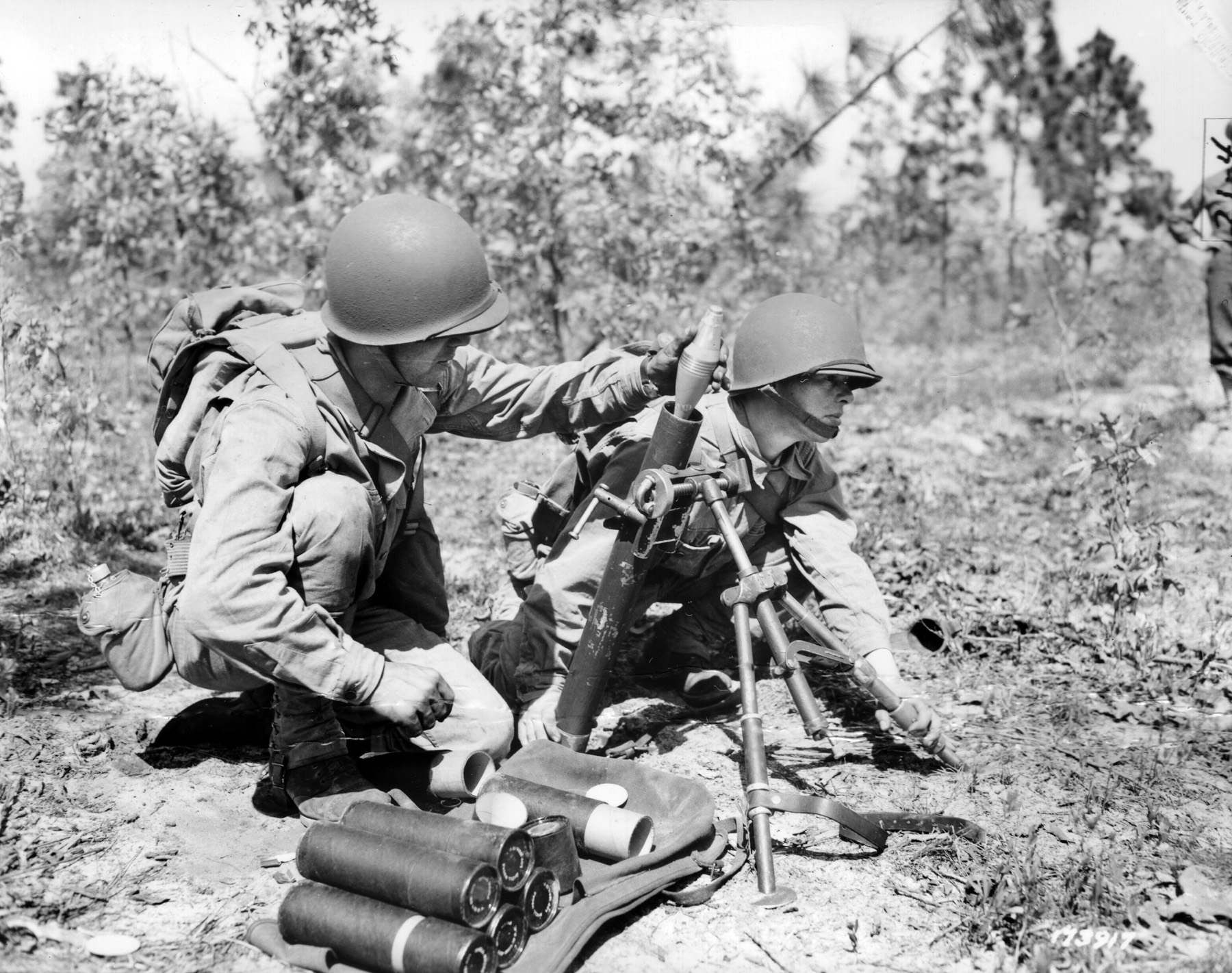
Six days out of New York, the convoy ran into a hurricane that sent waves 40-50 feet high crashing over the decks and restricting all Army personnel to below decks, where half the men were seasick. Somehow Rincker was not afflicted.
On the 12th day, land was sighted: North Africa. The convoy sailed past the ancient city of Tangiers, Morocco, and into the narrow waters of the Strait of Gibraltar. Rincker said, “Word soon spread that we would reach Marseilles, France, the next morning—October 20. The port facilities had been completely destroyed. There were numerous capsized ships in the wrecked harbor.”
The troops disembarked into LCIs (Landing Craft, Infantry) and were trucked about 12 miles inland to a staging area where, late in the afternoon, the regiment began setting up tents. A heavy rain that night nearly flooded the staging area.
The 14,000-man 100th Division, made up of the 397th, 398th, and 399th Infantry Regiments, was under the command of 49-year-old Maj. Gen. Withers A. “Pinky” Burress, who had been with the division since its activation in November 1942. A 1914 graduate of the Virginia Military Institute, he saw action with the 2nd Infantry Division in France in World War I. A competent, well-liked commander, he would remain in charge of the division throughout the war.
The 100th was attached to Lt. Gen. Alexander Patch’s Seventh Army and received its orders to head north out of Marseilles. Ahead of the 100th were the U.S. 3rd and 45th Infantry Divisions, which had taken part in Operation Dragoon—the invasion of southern France—on August 15, 1944. The 100th Division was on the move up to the Vosges Mountains, 450 miles from Marseilles.
“We passed hundreds of German vehicles riddled with bullet holes or burned,” Rincker recalled. “Sometimes there were wagons with dead horses attached to them. We were told that the U.S. Air Force had inflicted this tremendous damage as the Germans were fleeing from the attacking Seventh Army. The weather had been rainy and dismal during the three-day trip north. We were cold and cramped from the long [truck] ride, but it sure beat marching!”
On November 1, the weather cleared and the 100th arrived at the town of Sainte-Hélène in Alsace-Lorraine. “We were only six miles from the enemy and could hear the booming noise of ‘friendly’ artillery going outbound into enemy territory,” Rincker recalled.
“One of the first tasks was to remove all division patches and all stripes denoting our rank—the very things we had spent numerous hours sewing onto our new uniforms just before leaving Fort Bragg! Officers and NCOs were now indistinguishable from the enlisted men. This was done to prevent enemy snipers from picking off our leaders and from the enemy being able to identify our unit if we should be captured.”
On the afternoon of November 5, Rincker’s regiment mounted 21/2-ton trucks that would take them to the front lines to relieve elements of the 45th Division, which had been at the front for 80 days. Rincker and his “foxhole buddy” George Wild soon found themselves on the banks of the Meurthe River across from the village of Baccarat.
“For the next couple of days, the situation was static,” said Rincker. “We did not have actual contact with the enemy and thus we didn’t know just where they were. We were also experiencing the most inclement weather imaginable. It would rain and then snow. We were miserable from the cold, wet, soggy weather and at the same time scared stiff. We would jump at the least little sound made near us, expecting to be ambushed by some hidden enemy.”
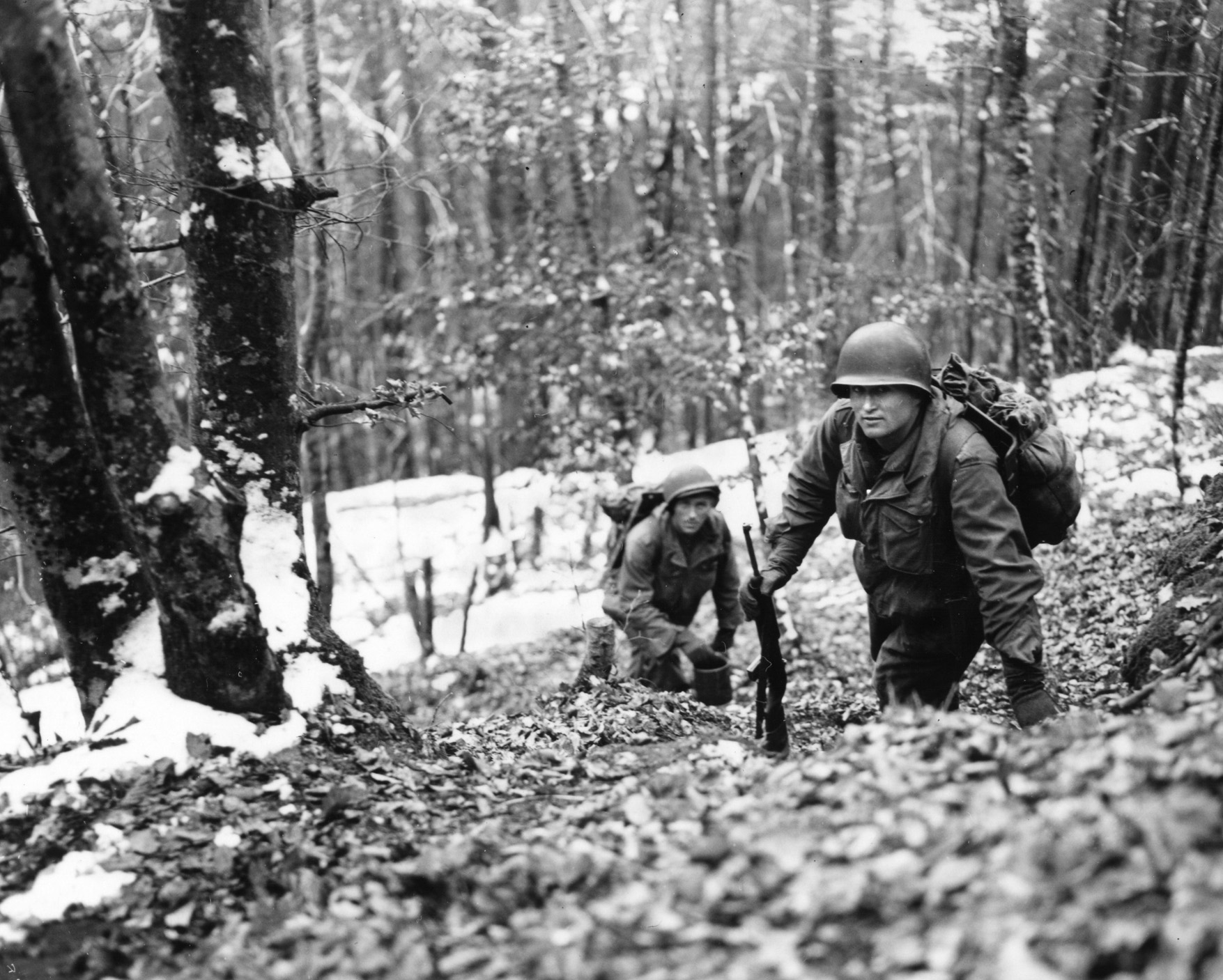
On November 7, Rincker’s regiment moved forward and made contact with the Germans, suffering its first casualties. The division was ordered to prepare to attack Raon l’Étape, a heavily fortified town on the high ground above the Meurthe River. On November 11, the attack began.
“As we moved forward,” Rincker said, “we came under small-arms fire, as well as mortar and artillery fire. Casualties began to pile up. Our mortar platoon escaped having any casualties the first day but, on the 13th, Lieutenant Nelson was wounded and removed from battle. Within the next several days we had two men killed and five men wounded. You never knew if you might be next.
“We were scared to death but we had a job to do and orders to follow. On November 16, our regimental commander, Colonel William Ellis, was ambushed on his way to a battalion command post (CP) and machine-gunned to death.”
Rincker never forgot the first dead German he saw. “We were advancing through some thin woods with the riflemen out in front of us, perhaps 200 yards. There had been some firing, but we continued moving forward. I saw this body lying right ahead of me and I knew from his uniform that it was a German.
“He was lying on his back, and as I passed I could see that he was a young fellow about my age and of similar build, looking straight up toward the sky. I couldn’t help but wonder about his background, his aspirations, his family, and maybe what his last thoughts had been. It put a real chill up my back, and I have never been able to dismiss the sight of him.
“As time went on, I saw hundreds of dead Germans, but they did not have the same effect on me. Perhaps it was because he was the first dead human being that I had ever seen. Or perhaps it was because I realized that, at any particular moment, I, too, might be stretched out, dead.”
On November 18, the 100th Division took Raon-l’Étape. “Just as we reached the edge of town,” Rincker remembered, “some Frenchmen were passing out drinks in appreciation for being liberated from the Germans. They were so happy!” Rincker took a big swig that burned all the way down and nearly knocked him off his feet. “I had expected some good wine, but that old Frenchman had given me a shot of his best cognac. I never again accepted a drink from an appreciative Frenchman.”
The division resumed the attack on November 19 and, by a series of quick moves, caught the Germans off guard and took the towns of Moyenmoutier, Senones, La Petit Raon, and Vieux Moulin. “We had covered 35 miles in 15 days,” Rincker said. “We had suffered casualties all the way and had been scared all the time.”
He also noted, “We began encountering situations that were not at all like we had in training. We had gone into combat with full field packs, which we discovered were impossible to carry while fighting in the wooded Vosges Mountains. We also discarded our shelter halves, blankets, and mess kits; we were eating nothing but K-rations, anyway. We kept our canteens, canteen cups, raincoats, and some personal items like writing paper.
“The next big problem for our mortars was that we were setting up in the woods and had to cut down some trees to get a clear field of fire overhead. We had no way to cut the trees at first, but soon we had some full-sized axes and shovels brought up from our rear. We had to hand carry our ammunition because the supply jeeps couldn’t get up to us in the mountains where there were few roads.
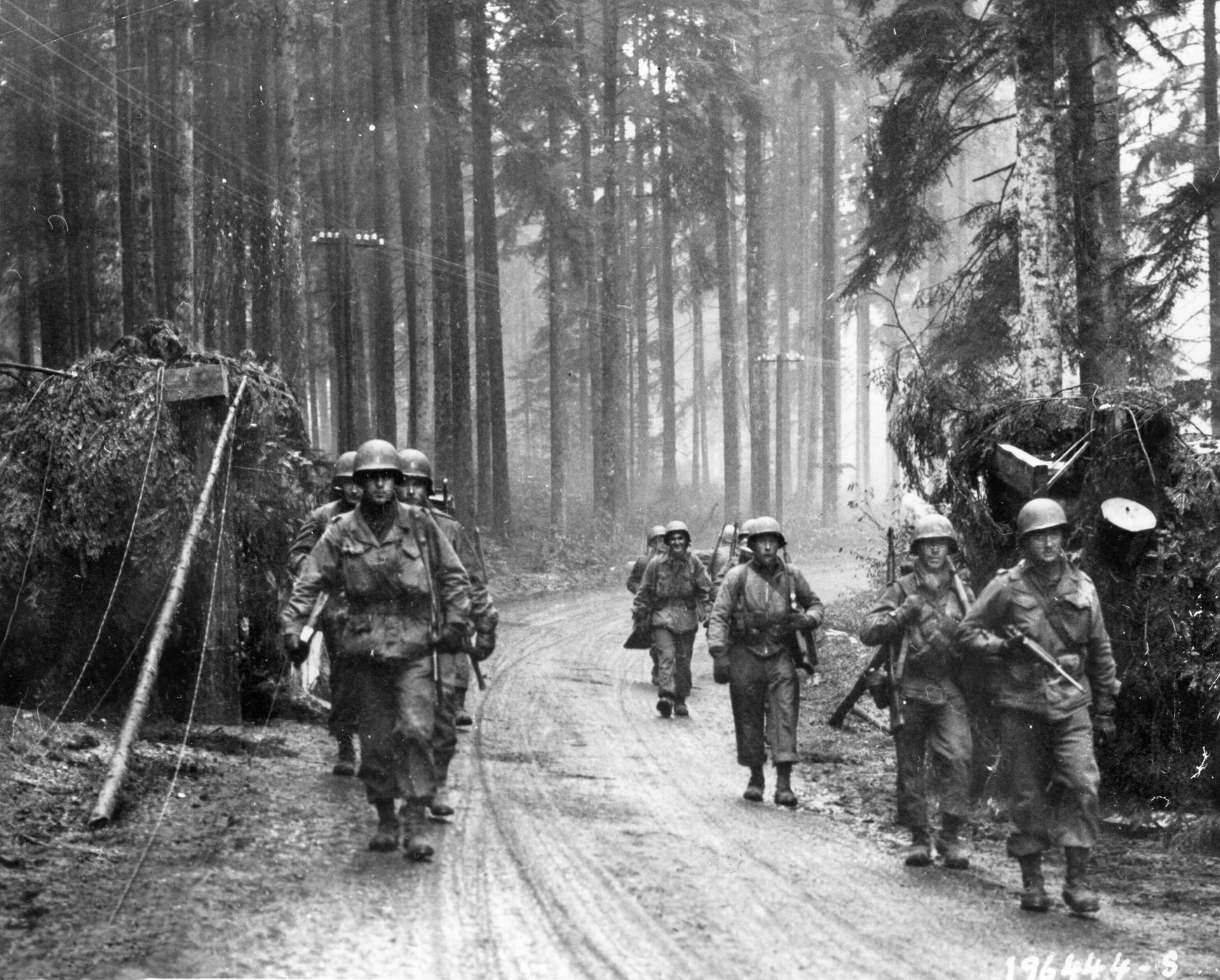
“Of all the fellows from the Eastern states where the woods abound, not one man in my squad knew how to cut a tree down! Therefore, I soon became the woodsman while George dug a foxhole for the two of us. Many days we cut down trees and dug foxholes three or four times a day after each advance.
“Then we were soon subjected to a new danger not covered in training. Incoming 88mm shells or mortar shells were hitting the trees and bursting in the air over our heads, throwing shrapnel down into our open foxholes. To gain protection from tree bursts, we started throwing logs from our cut-down trees over our foxholes; at night, we would cover the logs with dirt for added protection.”
Rincker noted that fighting in a forest was especially difficult because the sight distance was extremely limited, and it was easy for the Germans to mount ambushes: “There was at least one instance when a German climbed a tree and waited for us while we set up our mortars. This sniper suddenly opened up on us, throwing us into a frenzy until we discovered him in the tree over us. That sniper didn’t have a chance once we located him. He had tied himself to the tree so his body didn’t fall out; we just let him hang there.”
By some miracle, the sniper had not hit any of the mortar crew, but from then on Rincker and his squad checked every tree before setting up their mortar.
On Thanksgiving Day, 1944, the 397th Regiment was advancing through more of the dense woods that covered the Vosges Mountains. It was cold and raining hard; the men were miserable. “We were told that a hot Thanksgiving dinner was being brought up to us,” said Rincker.
“We were moved to an area where we were to receive our hot dinner, but by the time I got to the food area all that was left was crushed pineapple. I got my canteen cup filled about three-quarters full but, with all the rain, it was thin enough to drink. That was my hot Thanksgiving Day dinner!”
Later that day, Rincker’s battalion was ordered to move out and continue the march, carefully avoiding mines that had been planted in the tree-lined road. That evening, as Rincker related it, “There was a quick burst of small-arms fire up ahead and the whole column stopped and ran into the edge of the woods.” The column had run into a German roadblock constructed of fallen timber.
Skirting the roadblock, the battalion continued on until it was again halted by more roadblocks and harassing rifle and machine-gun fire. “It became pretty apparent that we were penetrating the German lines and going deep behind them. We learned later that we were 17 miles behind German lines!
“We soon were in control of the town of Saint-Blaise. The rest of the night and all the next day we captured more Germans as they came into the town, not knowing we were there. There was little or no shooting as we stayed in the buildings and just allowed the Germans to walk into our waiting guns. As soon as they were captured, we put them in a basement under guard and waited for more to show up.”
The Yanks also discovered a wine cellar. “There were some very high-quality French wines and champagnes liberated that day,” Rincker recalled. “I shared a five-star bottle of champagne with several others in the mortar group.”
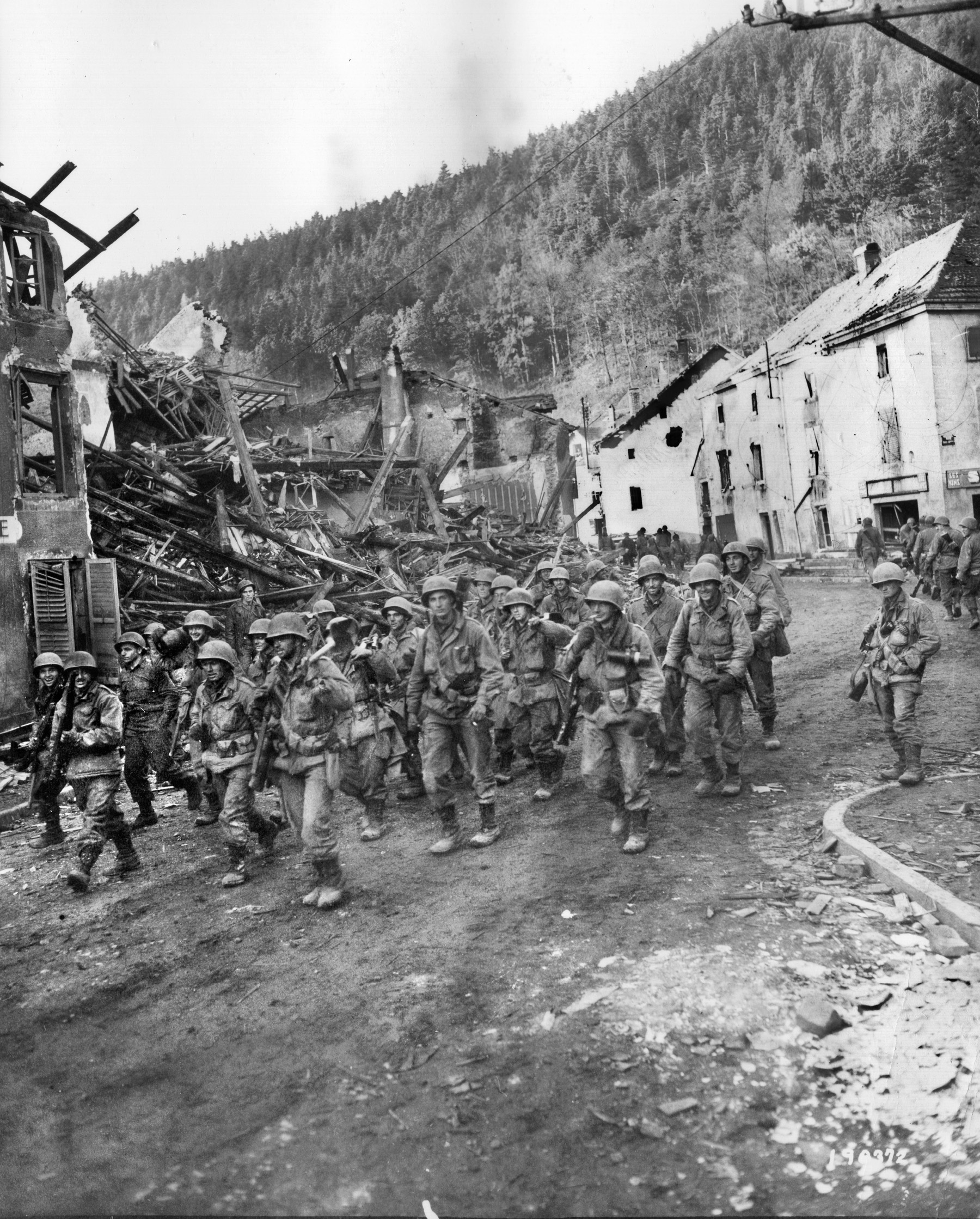
Rincker said that his unit had been in combat for 21/2 weeks and had not been able to shave, wash their hands, or change clothes. While at Saint-Blaise, he said, “Some general showed up and raised hell with us because we had not shaved. The truth of the matter was that we couldn’t shave because none of us had razors.
“Before nightfall, a truckload of Red Cross supplies arrived in which there were little O.D.-green cloth bags containing toothbrushes, toothpaste, plastic razors, and a pack of five razor blades. Our steel helmets became washbasins into which we scooped cold water out of a nearby stream. We used up most of our razor blades trying to scrape off nearly three weeks of beard growth. Our faces seemed bare and cold after the beards were removed.”
With the capture of Roan-l’Étape and Saint-Blaise, the Century Division had successfully cracked the German Winter Line in the Vosges Mountains. Rincker reflected, “We were no longer ‘green’ troops. We were now veterans who had achieved an important Seventh Army objective. We had met the Germans on terrain which had never before been invaded successfully and had emerged victorious. But we had paid a price for our victory. The 397th Regiment had lost 167 men killed and 511 men wounded.”
And, unknown to Rincker, much sterner tests were still ahead.
In late November the division fought a number of skirmishes in Alsace-Lorraine. As Rincker and his unit were preparing to attack Ingwiller, they encountered Germans that fought with “suicidal ferocity. They used small arms, automatic weapons, mortars, 20mm flak guns, and the most-feared of all: the 88s.
“If we got caught in a mortar barrage, the mortar shells dropped quietly from the sky with little, if any, sound,” Rincker said. “But when we got caught in a barrage of 88mm artillery fire, the sound of the shells screaming toward us scared the hell out of us. The psychological effect was as bad as the actual shells bursting all around us. I am not sure you would hear the shell that was headed right at you, but the shells going over or to either side made a terrible screaming sound due to the high velocity at which they were fired. You just knew that one was going right up your back.”
One night, Rincker’s unit was the recipient of a particularly nasty mortar barrage; luckily, the men were in their covered foxholes. “There were the usual flashes as each shell went off, followed by the roar of the explosion. Sometimes, if the shell hit fairly close, dust would sift down from between the logs over our heads. This particular night, a shell burst on the ground right beside our hole and our whole area really shook, and dirt fell on us from all around.
“There was a moment of deathly silence, followed by the noise of each of us feeling our arms, legs, and body to see if we were all in one piece. We were all unhurt but had dirt all over us. The next morning, we got out of our hole and saw that the shell had hit about two feet from the edge of our hole. Our mortar was not hurt, but some mortar ammunition was messed up so badly that we couldn’t use it.”
And so it went, with the division trying to move forward and the Germans doing everything in their power to stop it.
In December, due to casualties in his platoon, Rincker was promoted to acting squad leader. Attacks against the villages of Rothbach, Reipertsviller, and Wingen were launched but without much success. The 1st Battalion of the 398th Regiment, about five miles from Rincker’s 397th, tried to take Wingen, but most of Company A was captured by the Germans.
The men continued to suffer from endless rain, mud, snow, and sub-freezing cold. Food was scarce, and water could only be obtained by filling canteens in a stream or melting the snow; Halazone tablets were used to purify the water.
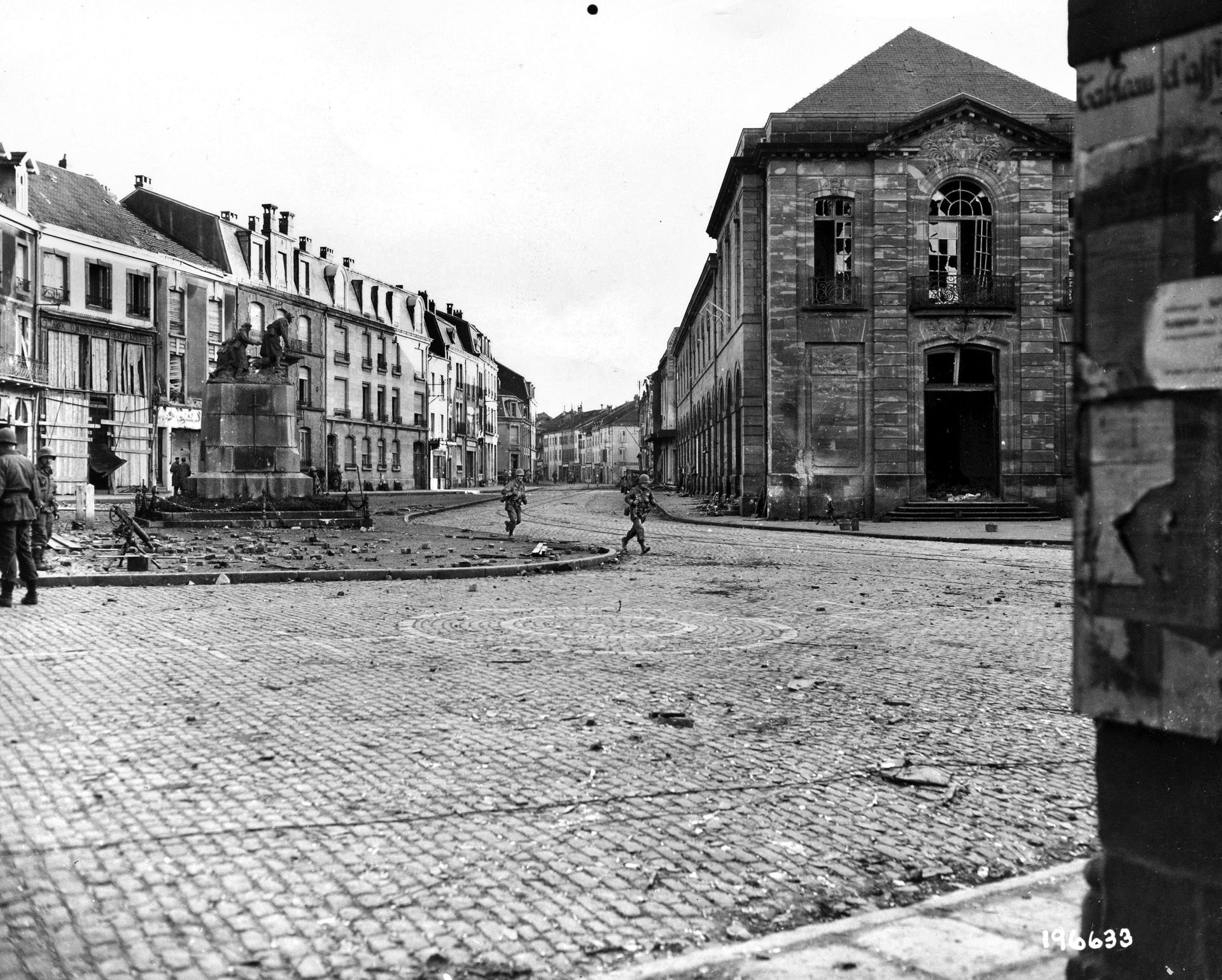
“We had gone nearly a month without anything but our blankets to wrap up in at night,” Rincker recalled. “There were some nights I was so cold that sleep was just impossible.”
Finally, the unit got some relief. Truckloads of mummy-type sleeping bags reached the front. “Even though these new sleeping bags were pretty thin,” Rincker said, “They were a great help, especially with our raincoats over them.”
The 397th was attacking Hill 335 near Mouterhouse. Rincker recalled, “Death in combat usually came in a burst of machine-gun fire or an artillery barrage. It normally came when the individual knew he was in danger. But Lloyd Neseth’s death on Hill 335 stunned us all.
“We apparently had not been detected as we came up in the dark, and the next morning that condition seemed to still exist. We were ready to begin the battle for Mouterhouse but were waiting for the assigned time of the attack. Thus, we were just waiting in the woods above the town.
“Lloyd had sat down and leaned up against a tree and several fellows were sitting on the ground visiting with him. Without even a grunt, Lloyd keeled over and was dead! No one heard a sound from a sniper’s rifle or any other weapon. Yet Lloyd had died from a single rifle bullet in the middle of his forehead!
“Needless to say, we searched the area for a sniper but found nothing. We never knew where the bullet came from.”
The December 7-10 battle for Mouterhouse was difficult. The Germans resisted with great determination because they were fighting on their border, but eventually the Americans prevailed.
Company H was in bad shape, though; two machine-gun crews had been captured by the Germans, and a platoon leader had been seriously wounded. Many other men in the company were also either dead or wounded. Moving forward was slow and painful, with the 397th absorbing everything the Germans could throw at it.
Thoughts turned to home in the middle of December when Christmas packages began arriving. Rincker received a pair of woolen mittens that he wore through the rest of the war.
“My folks sent food items, too,” he said, “and it didn’t really matter what, because anything different from a K-ration was a most welcome change. Another big treat came my way about this same time. They started taking a few of us out of the line and sending us back for showers. I had not had a shower since I left the ship!”
Soon it was time for another attack—this time against Germans holed up in the town of Bitche. “Also about this time we were beginning to come up against the fortifications of the Maginot Line,” Rincker said. The Maginot Line had been built by the French in the 1930s to forestall another German invasion.
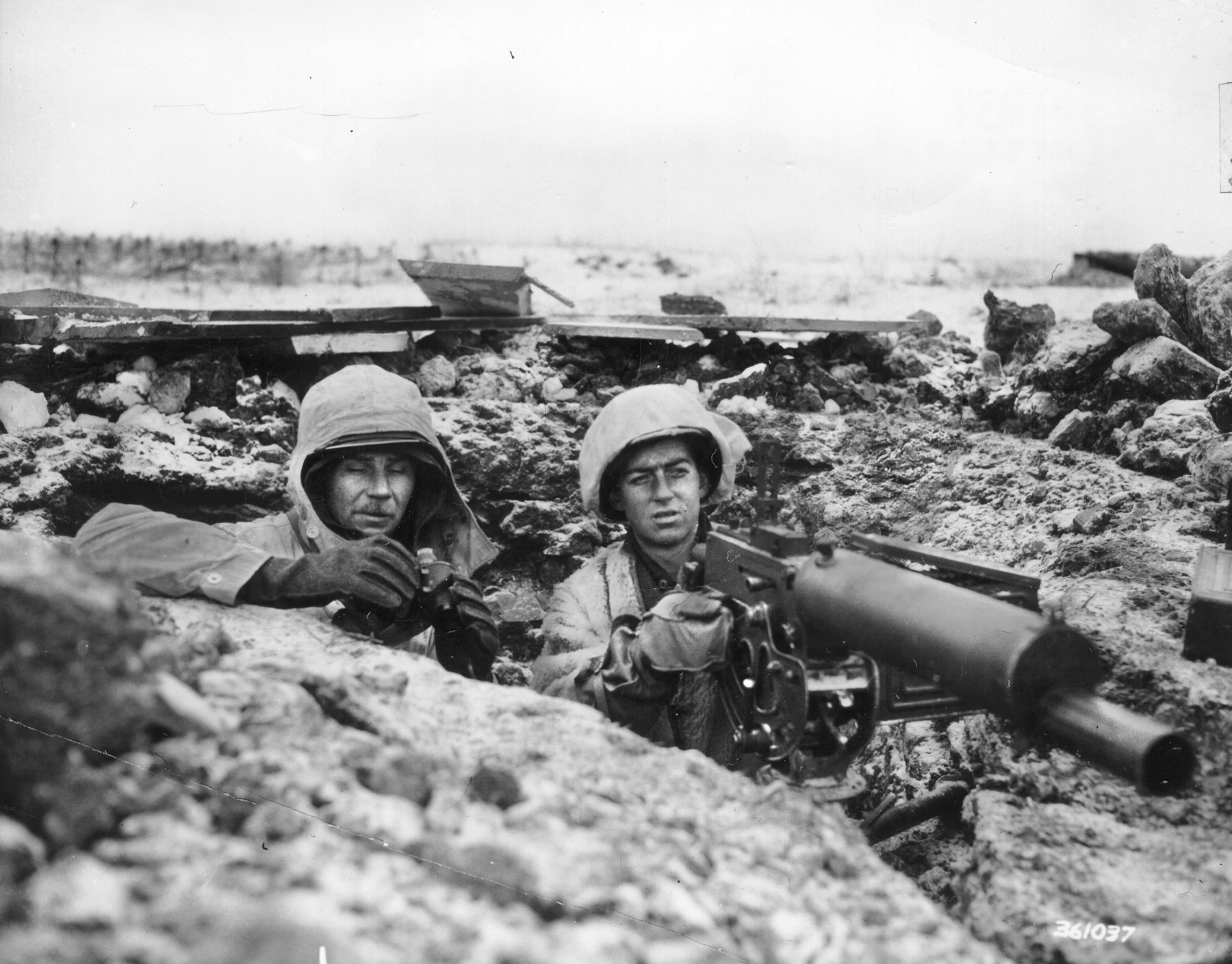
“These fortifications ranged from concrete-reinforced pillboxes from which well-protected machine guns could fire, to huge bunkers that housed not only machine guns but had ports from which various sized cannons were fired. Some of the bigger fortifications were five to seven stories deep, had barracks, mess halls, hospitals, ammunition reloading facilities, and an underground electric railroad to connect the bigger bunkers with one another.”
The attack on Bitche and Camp de Bitche, a military cantonment, was scheduled for December 17. It began with hundreds of American dive-bombers swooping down on Camp de Bitche and blasting everything in sight; artillery and mortars pounded the installation, too. Rincker’s battalion launched a diversionary attack that enabled the other units to catch the Germans unawares.
Just as it appeared the Americans were on the verge of driving the Germans out and capturing Bitche, word came down that farther north in Belgium the Germans had launched a tremendous counterattack that would become known as the Battle of the Bulge.
Rincker said, “The situation in the Belgium Bulge grew worse each day,” resulting in General George Patton’s Third Army being rushed northward and Seventh Army moving in to fill in the gap that the departure of Third Army had created. “We were ordered to discontinue our attack on Bitche and take up defensive positions farther north.”
Rincker’s unit broke off contact and loaded into trucks that hauled it to Petit Rederching to relieve the 1st Battalion of the 114th Regiment, 44th Infantry Division, about 10 miles directly west of Bitche. “This was the second time in as many months that we were hauled from one front and immediately committed to another,” Rincker said.
“By the evening of December 24, two rifle companies of our 2nd Battalion were dug in on the outpost line just north of Rimling. On Christmas morning 1944, our division was on the defense for the first time since we had entered combat. Each battalion was now covering as much of the front as an entire regiment normally would. We were spread thinly!”
Shortly before noon on Christmas Day, a strong German attack developed—or so the Americans believed. What appeared to be a mob of charging Germans coming over the hill turned out to be a mob of panicked, retreating GIs.
According to Rincker, “A panic situation had developed and we were running and not even being fired upon. There was no semblance of a controlled retrograde movement as I had been taught in OCS. There was so much confusion that we didn’t know whether we were retreating because of the danger of being encircled or if the enemy forces in front of us were too powerful to be stopped by our thinly placed rifle companies.
“I don’t know who made the decision or how they managed to bring this rout to a halt, but when we did stop, we had retreated six miles from our former positions! At any rate, the 1st and 3rd Battalions were moved into the area of Rimling and Urabach and cut off two enemy attacks aimed for our sector.”
Before being pushed back, the German attackers had managed to steal Company F’s Christmas dinner along with 25 new fleece-lined parkas.
As the weary GIs settled in for a long, cold night, an engineer company was brought in with jackhammers to break the frozen ground so the soldiers in the 2nd Battalion could dig foxholes.
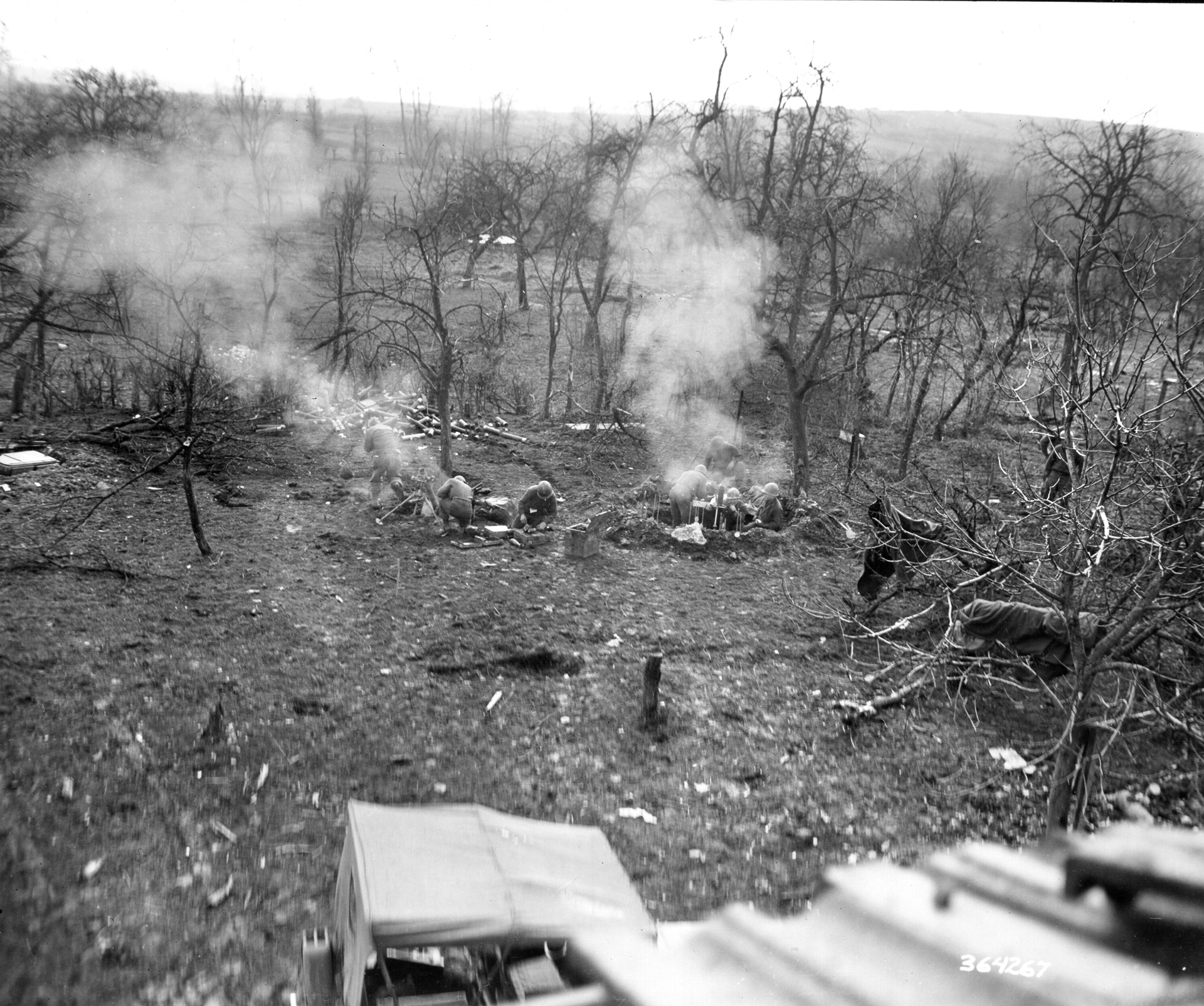
A few days later, while still in their defensive positions, the 397th Regimental command post was bombed by American P-47 fighter-bombers, killing six and wounding eight. It was later learned that the planes had actually been captured by the Germans and, with German pilots, were targeting the American positions.
The 100th Division received reports that the situation in Belgium was deteriorating, so the men were put on alert that a strong German attack might be headed their way. This second German counterattack, against American forces in the Alsace-Lorraine region, was code named Operation Nordwind (North Wind).
On New Year’s Eve day, a heavy snowfall blanketed the area. Shortly after midnight on January 1, 1945, as Rincker put it, “All hell broke loose. This was the expected attack. It was made without any artillery preparation to gain surprise. There were four or five German companies attacking against our 3rd Battalion in Rimling. The whole Seventh Army front was under attack.
“Each enemy drive was made by numerically superior forces, with tanks, self-propelled guns, and limitless amounts of artillery and mortar barrages that eventually reduced the town of Rimling to ruin.”
The strongest enemy drive was made against the 397th’s 3rd Battalion to the left (west) of the 2nd Battalion and against the 44th Division to the left of the 3rd Battalion. The 3rd Battalion managed to hold, but the 44th’s front crumbled, allowing the Germans to attack 3rd Battalion’s flank. It was touch and go for a while, but 3rd Battalion was able to fight off repeated attempts at penetration.
On the 100th Division’s right flank, the situation was also becoming precarious. The Germans launched an attack from Bitche against the 117th Cavalry Recon Squadron on the 399th Regiment’s right flank and drove them back, thus exposing the 399th’s eastern flank. If the Germans could get around both flanks, they would have the division surrounded. Fortunately, that did not happen.
With their ground attacks having failed, the Germans were content to simply shell the 100th Division for the next two days. Rincker and the 2nd Battalion, 397th Regiment, were moved into Rimling in anticipation of the next enemy assault.
Rincker recalled, “We knew another big attack was imminent as our observers in a church steeple had seen the big buildup of enemy forces directly in front of us. At 3 am on January 8, the enemy laid down a tremendous concentration of artillery and rocket fire on Rimling, Hill 375, and the entire area around the town. Exactly one hour later the attack came.
“An estimated 200 German infantry, supported by 10 to 14 tanks, attacked in the first wave, with self-propelled guns and engineers with flamethrowers hitting Companies E and F in a two-pronged attack. The Germans charged our positions standing upright, firing their weapons, and shouting madly. They overran both companies but took terrific casualties. We could stop the infantry but had no way to stop the Tiger tanks. Bitter and bloody fighting continued until daylight.
“When the first attack came, our heavy machine guns raked the advancing Germans with deadly fire. They had to fire between the tanks, around the tanks, and behind them to get the charging infantry. We on the 81mm mortars began firing into our predetermined fields of fire as fast as we could. But when the Germans got on top of our rifle and machine-gun positions we had to cease fire to keep from hitting our own men.
“By dawn the Germans had worn out their efforts and fell back to regroup. The number of dead Germans in front of our positions was almost unbelievable. By comparison, our losses were surprisingly few.”
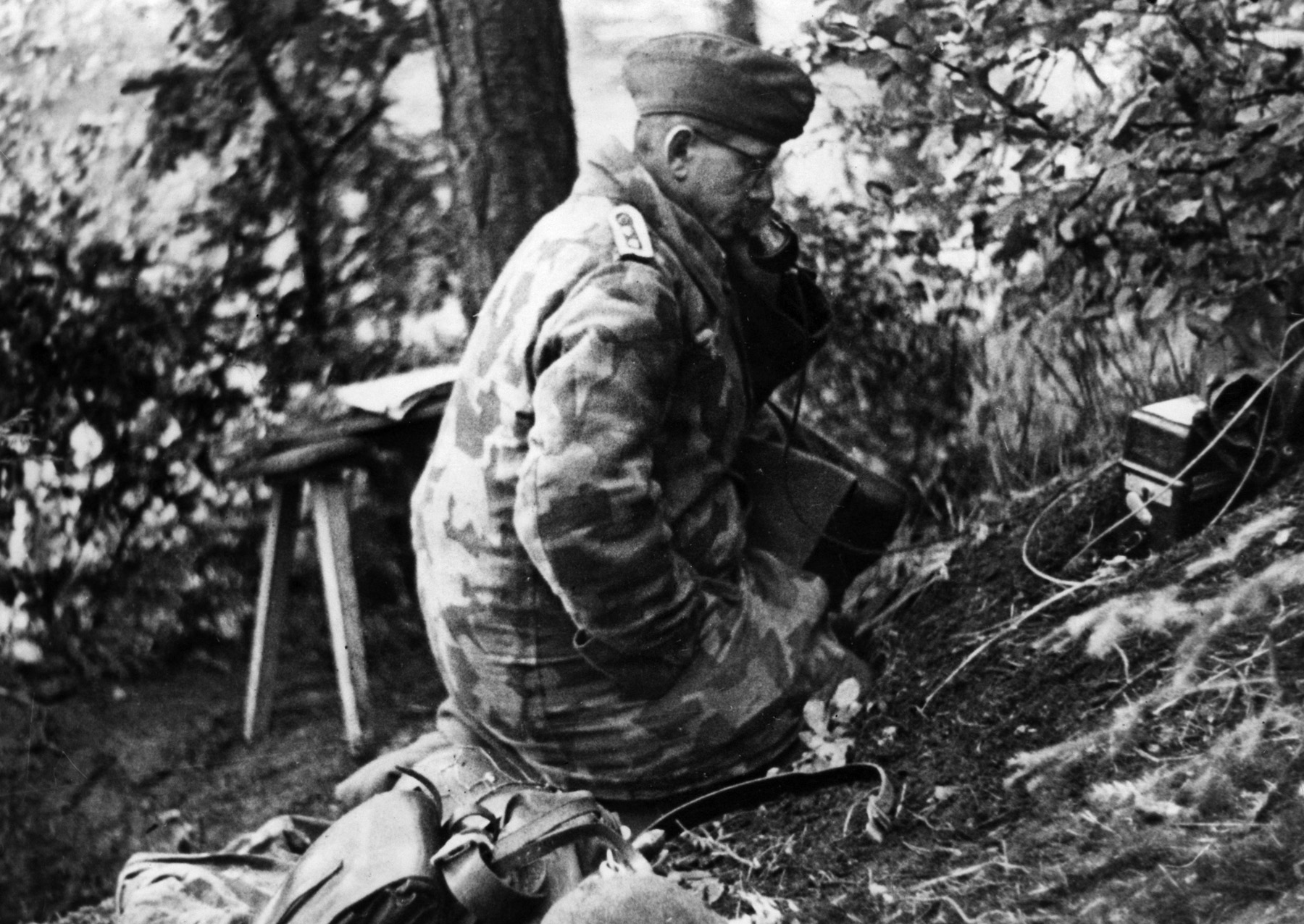
Although the Germans had fallen back on January 8, they nevertheless kept up the pressure with artillery, mortar, rocket, and tank fire. They had cut the Rimling-Guising road, occupied Hill 370 south of Rimling, and were occupying the western portion of the town. American tanks tried to push German armor off Hill 370 without result.
On the 8th, Tech. Sgt. Charles F. Carey, Jr., 397th Regiment, distinguished himself in battle. As a member of an antitank platoon, he saw the wave of Germans and panzers heading his unit’s way but was powerless to do anything about it, as the Germans had destroyed his antitank guns. Carey quickly organized a patrol to prevent two of his squads from being overrun.
He then took a second patrol to attack a house that was occupied by enemy snipers. Covered by the patrol, he ran to the house, killed two snipers, threw in a grenade, and then went in and came out with 16 Germans. He organized another patrol and damaged a panzer with a bazooka; as the crew emerged, he shot them down with his rifle.
The next day, Carey discovered that Germans had entered Rimling and chased four of his men to the attic of a building. Disregarding his own safety, he maneuvered an old staircase to an outer wall of the building so his men could escape. Later that day, while attempting to reach an outpost, he was shot and killed by a sniper. For his courageous actions, he was awarded the Medal of Honor posthumously.
The final assault by the Germans came on January 9. Rincker said, “The best-trained SS troops with huge amounts of supporting weapons were thrown at us for this final drive. Our riflemen were so dazed, shocked, and exhausted that they couldn’t hold out much longer. They just couldn’t keep the holes plugged, and more Germans were getting through the gaps.”
But the Germans in front of Rincker’s position were just as dazed, shocked, and exhausted as the GIs, and some began to surrender. Eventually Rincker’s unit took 32 prisoners. “I got a German sub-machine gun from a German who surrendered to me. I also got two spare magazines of ammunition. I carried this gun with me for quite a few days until it got too heavy and I didn’t really need it anymore.”
After a few hours, the situation in front of the 397th had stabilized. “We left 26 Germans laying in the snow,” Rincker said. “Of the prisoners, many were wounded. Our medical aid man did all he could for the wounded before we gathered them together and marched them toward our rear. One of the SS officers that we captured was furious that a measly mortar crew with only about 20 men had wiped out his company of 58 men. They were all that was left of an entire German rifle company that had attacked in the Rimling area a few days before.”
The 397th had suffered, too. During the Battle of Rimling, the regiment lost about 350 men, of whom 79 were killed. As a tribute to their courageous stand, Rincker’s Company H received a Presidential Unit Citation.
On the night of the 9th, the 397th was ordered to pull back about a mile to straighten the front line. Rincker reflected, “The thing that the Rimling defense taught us was that when we were in a defensive position the enemy could hardly blast us out of the position without tremendous cost in personnel and material. That memory clung with us as we eventually returned to the attack status and fought our way into Germany.”
And fight they did. Once the German attacks of Operation Nordwind died away and it became clear that the enemy had gone back to defending their homeland, plans for offensive action to cross into Germany were drawn up by the Americans.
The rest of January, February, and the first half of March passed with little but probing enemy patrols and occasional shelling to deal with. At 5 am on March 15, Seventh Army began its spring offensive.
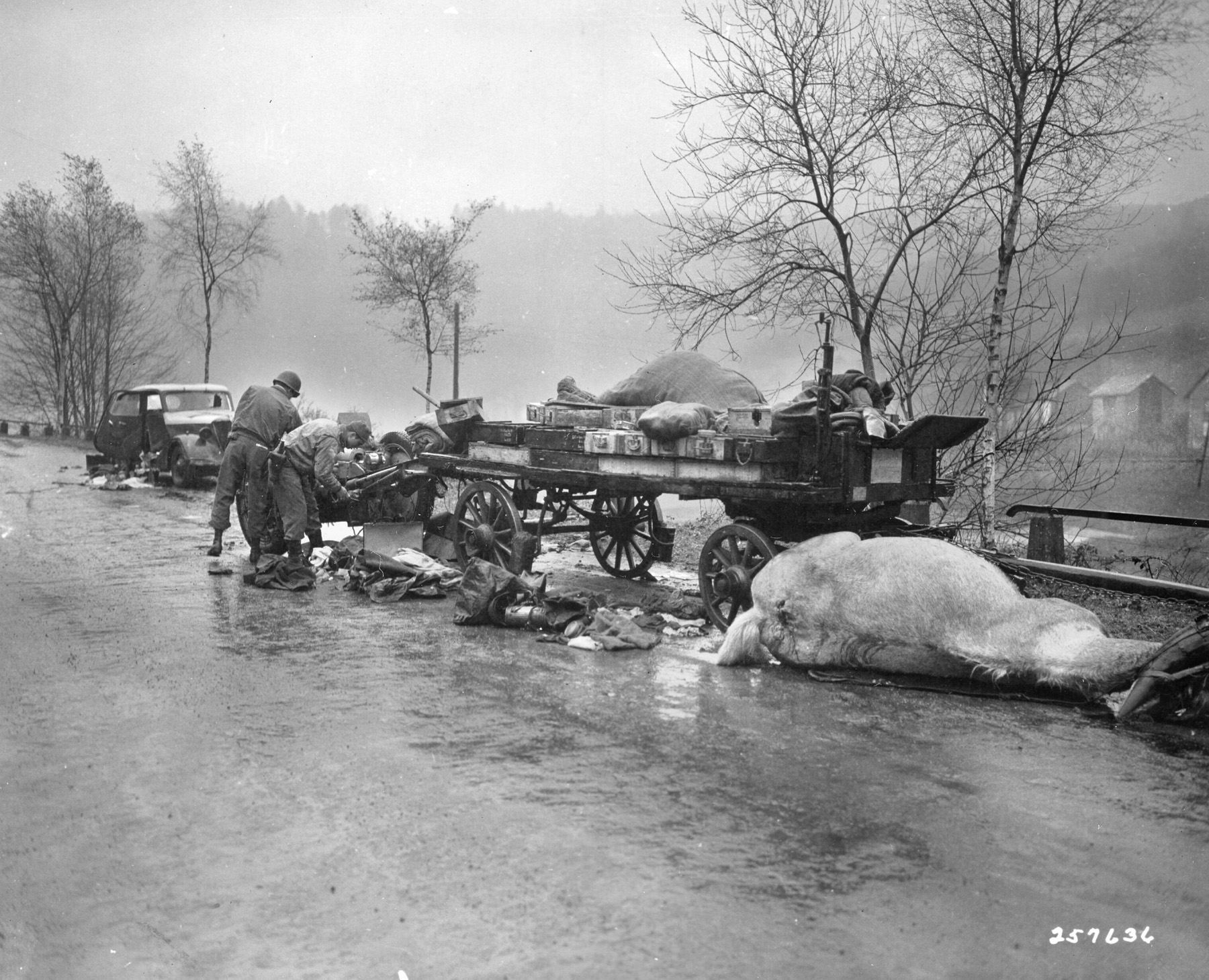
“The enemy threw in heavy artillery and ‘Screaming Meemie’ [multi-barrel Nebelwerfer] rocket fire at us in Hottviller,” Rincker said. “The ‘Screaming Meemies’ usually came in salvos of six with a screaming noise that scared the hell out of you. When they hit, there was lots of concussion but not much shrapnel. The riflemen were suffering casualties from stepping on wooden ‘schu’ mines buried just under the soil surface that couldn’t be detected by mine detectors; those unlucky enough to step on one lost a foot or part of a leg.”
As a rocket barrage began, Rincker ducked into a stone building. “One of the rockets hit the building I was in and blew a bunch of broken stones down on top of me. Fortunately, none of the stones was big enough to hurt me, but one piece hit my wristwatch and broke the crystal. This was the watch my parents had given me as a college graduation present and which I had lost and found twice before while being on marches in France. The minute hand was jarred loose so that it didn’t keep time with that hand anymore; I could still tell time by the hour hand.”
The American attack had caught the Germans by surprise and rolled forward for two days, overcoming all opposition as it went. American warplanes also softened up the enemy for the infantry.
“Our spring offensive was now well underway,” Rincker said. “We had suffered casualties, and we had taken prisoners. The regiment accounted for 36 prisoners on the first day, and more were picked up each day we advanced.
“Most of the 397th was standing on the border of Germany itself. During the night of March 19 and the next day, the Germans heavily shelled three towns in the northern part of our sector. All of a sudden, we were being relieved by elements of the 66th Regiment of the 71st Infantry Division. We couldn’t believe our eyes when we saw the men of the 71st coming in carrying full field packs and wearing their division patches and neckties! Man, were they green! We may have carried full packs into combat but we sure didn’t wear neckties!”
The 100th Division was pulled back and given a brief rest prior to the coming attack. “Word went around that our next push would take us across the German border and into the Siegfried Line. Having experienced battle trying to take the Maginot Line, we had considerable concern about trying to penetrate the Siegfried Line,” Rincker noted. “We had come up on the back side of the Maginot Line, but the Siegfried Line would be a frontal assault.”arch 21 was spent making final preparations for the assault, and all men in the division were briefed on what the rest of Seventh Army and Patton’s nearby Third Army would be doing.
On the 22nd, the 2nd Battalion was ordered to move out. “Why was it always 2nd Battalion,” Rincker wondered. Nevertheless, the men climbed onto and into vehicles of all sorts and began moving. “We didn’t know if we were going in for more bitter fighting or what to expect. We were told that we were destined to make history, but we didn’t know whether we really wanted such an honor,” Rincker mused.
“Our operations were to be coordinated with the Seventh Army as a whole and the Third Army farther north to break the German resistance in the Rhineland south of the Moselle River. At 9:30 am on March 22, our completely motorized column measuring close to two miles in length rolled out of our assembly area at Schweyen, and we were on our way. We crossed the German border at 10 am and sped unresisted through the Siegfried Line. What a relief, except our mission was far from over.”
During the day’s drive, the 397th Regiment liberated 30 Allied prisoners and captured dozens of German soldiers. That night the column stopped and rested in an abandoned German caserne in the town of Pirmasens. The next day the drive continued at such a fast pace that it was difficult for supporting units to keep up. From windows in village after village white bed sheets were draped, denoting that the town had given up.
Hundreds of German soldiers, knowing that the war was lost, were also giving up, approaching the American column with arms raised. Rincker said, “We had cleared out the city of Neustadt and moved on to Assenheim for the night. There was no organized resistance now, but there were an ample number of snipers that had to be eliminated. We now knew that the final goal of this motorized task force was to take Ludwigshafen, a big industrial city on the Rhine River.” The regiment was told that if they found any bridges over the Rhine still intact, they were also to take those.
They found no intact bridges, but they did find tremendous death and destruction between Neustadt and Ludwigshafen caused by the U.S. Army Air Forces. “Side roads and adjacent fields were strewn with material, dead horses, and German corpses,” Rincker recalled. “Mile after mile of this devastation lined the sides of the roads and impressed us once again with the might of air power. This destruction relieved us of the burden of fighting against all that had been destroyed in just the last day or two.”
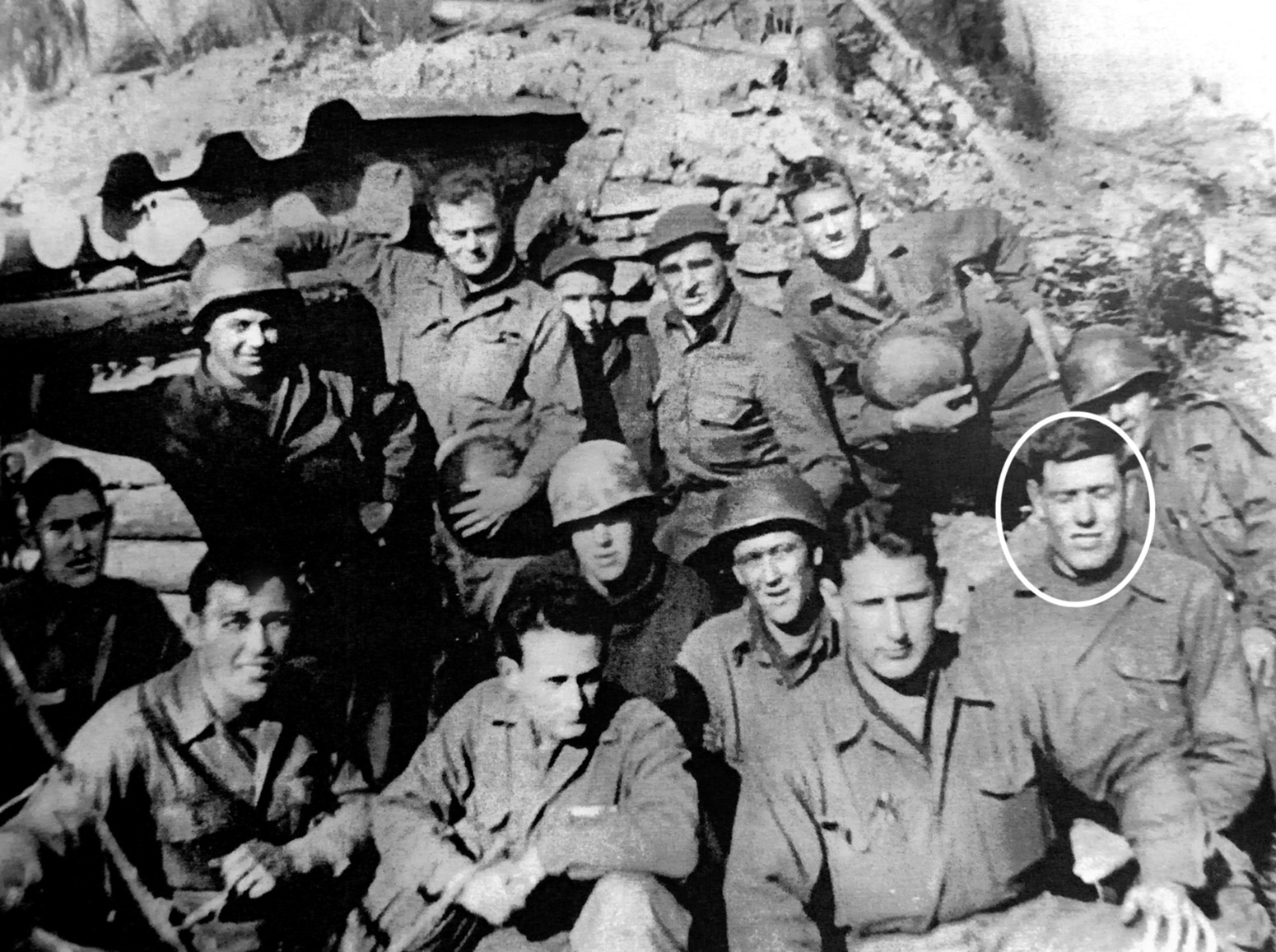
The swift arrival of Third Army to the north of the 100th Division had prevented many fleeing German units from crossing the wide river, and so they were squeezed between Patton’s forces and the Century Division, where they became easy targets.
“Even though we had been exposed to a lot of these scenes before,” Rincker said, “it was a pitiful sight to see a shell-shocked horse standing with dazed eyes and wobbling on its legs. It was a shame that it was left to suffer.
“Ludwigshafen was in ruins, either from bombs or fire. The 2nd Battalion took up positions in Oggersheim, just outside of Ludwigshafen. The 3rd Battalion and the rest of the division moved up from France and began taking up positions around Ludwigshafen. After the 3rd Battalion took up positions on the banks of the Rhine, they immediately came under mortar and artillery fire from the opposite shore.”
After clearing out snipers in the area, 2nd Battalion was given a break to clean up, take showers, and change into fresh uniforms. A USO show in Neustadt starring Marlene Dietrich was also made available to the men, who found it entertaining and relaxing.
The rest quickly ended on March 31, when the division mounted up and was trucked to a pontoon bridge that Army engineers had built to cross the Rhine between Ludwigshafen and Mannheim.
“We were moving out onto this long bridge. Each pontoon sank lower in the great river as each vehicle passed over it,” Rincker recalled. “The Rhine seemed very wide and we were anxious to reach the other side. On the far side, we passed through the bombed-out city of Mannheim and fanned out to the south along the east bank of the river.”
After pausing to catch its breath, the 100th Division moved out in attack formation toward Heidelberg, 10 miles away. On April 1, the 397th Regiment captured 337 German soldiers, bringing the total to 1,359 since they entered combat. An occasional roadblock was encountered, but these were quickly dealt with and the eastward drive continued.
Rincker recounted an incident that nearly cost him his life the next day. A German 88 opened up on the motorized column in which he was riding. Everyone jumped off the vehicles and dove into roadside ditches. After destroying several jeeps, the Germans switched to firing air bursts over the cowering troops.
He said, “Under that type of fire, the ditch offered no protection. I was looking for some place to get under cover when I saw several GIs running and diving into a culvert about 100 feet from me. I decided to do the same, but by the time I got there it was already full of men.”
He dashed across the road to see if the other end of the culvert was less crowded. “I jumped up and started across the road when suddenly a shell burst about 20 feet in front of me, right at the edge of the road. Another guy between me and the shell burst crumpled and fell, but I hadn’t felt anything and continued running.”
Luckily, Rincker found that there was room for him at the other end of the culvert. In the confined space, with dozens of other scared soldiers pressing around him, Rincker’s claustrophobia got the better of him and he left the safety of the pipe. He decided to see if he could help the soldier who had gone down while they were crossing the road, but Rincker discovered he was dead.
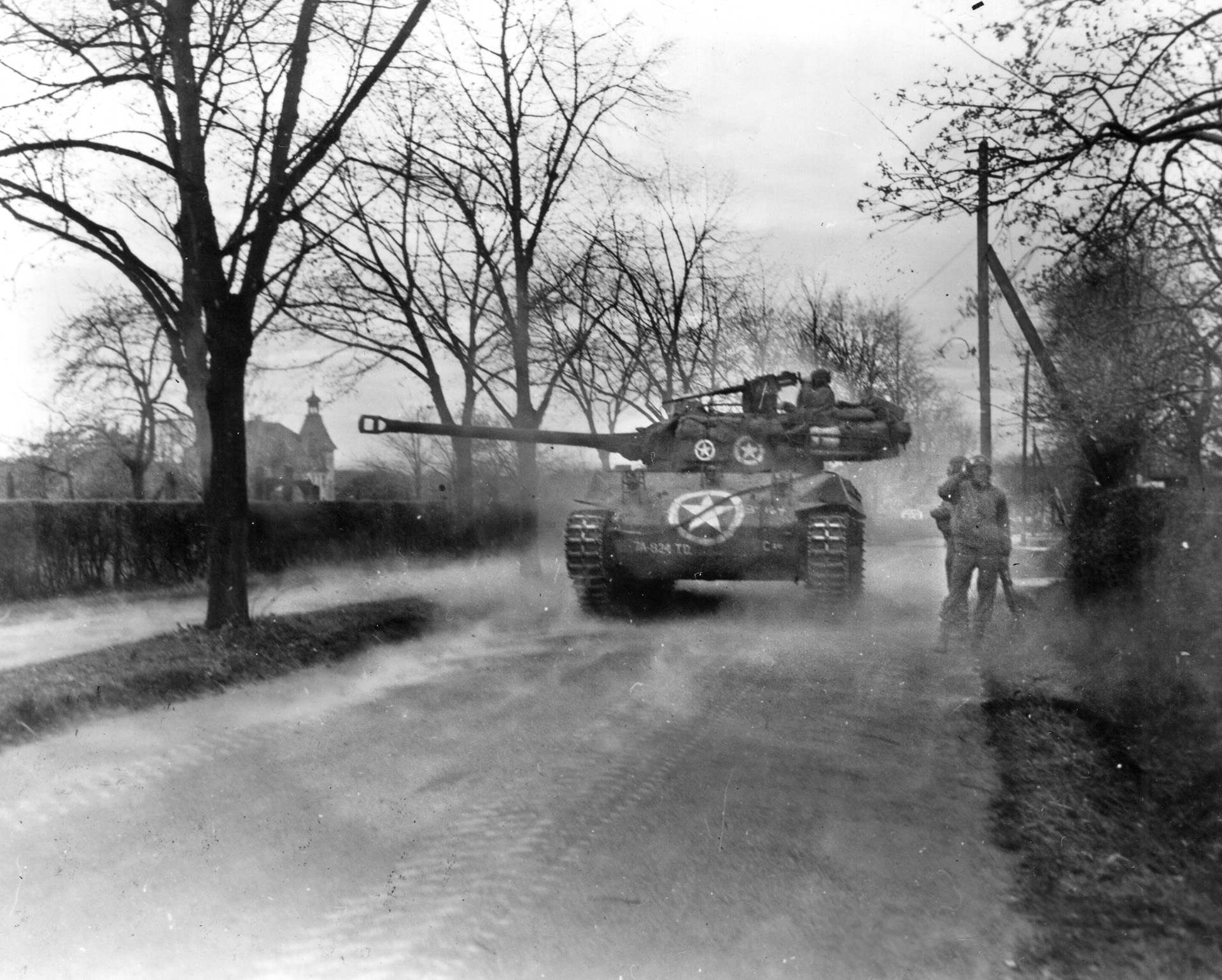
“The whole upper part of his body was riddled with shrapnel wounds instead of one or two fragments,” he said. “I have never been able to forget the sight of that guy laying there in the road. What really got to me was how this guy got hit so bad and I didn’t get a scratch, even though I was only about three steps behind him. It could have been me just as well as him.”
The drive continued, with the 2nd Battalion taking four towns before April 2 was over. In the attack on one of the towns, Rincker recalled, they dashed through a heavy barrage to reach the relative safety of the buildings. It seemed the deeper the Americans penetrated into Germany, the stiffer the resistance became.
The division bypassed Heidelberg, which had been declared an “open city” to spare it from destruction. At about this time the First French Army had crossed the Rhine at Speyer south of the 100th and made contact with the division’s right flank.
Rincker remembered a moment when his battalion entered a small German town and caught 300 enemy soldiers still asleep; they were all taken prisoner. “The German SS major in command was so upset over his capture that before anyone could stop him he pulled his Luger from its holster and shot himself in the right temple. It seemed unbelievable that anyone would kill himself when the war was nearly over. But it was apparently a great disgrace for an SS officer to be captured so easily.”
When the 2nd Battalion’s POWs were added to the rest of the regiment’s, the day’s total was 1,080—almost as many as the regiment had taken in the previous six months.
At one point during the division’s drive, a rest was ordered. Rincker was taking a break in a barn and watching a German woman milking a dairy cow. It reminded him of his younger days on the family’s Wyoming farm, so he approached the woman and through sign language let it be known that he wanted to help.
“The German woman was absolutely amazed, as German men evidently do not milk cows. And I am sure the idea of an enemy soldier wanting to milk a cow was hard for her to imagine. But I got a lot of satisfaction in doing something I hadn’t done for a long, long time. It removed me from the war for a few precious moments.”
The 100th Division was now bearing down on Heilbronn, an important rail and communications center on the Neckar River, following in the wake of the 10th Armored Division. Although some resistance was expected, no one thought it would be as determined as it turned out to be.
After his unit reached the river and found all the bridges destroyed, Rincker’s Company H was attached to Company E; he was assigned to be a forward mortar observer and, accompanying platoon leader Lieutenant Peter P. Petracco, carry an SCR-300 radio on his back to relay fire missions. The attackers crossed the river in small boats to assault a group of factory buildings.
Rincker stayed close to Petracco, following the leading riflemen. “The factory buildings were surrounded by a stone wall about five feet high,” Rincker said, “that gave our men both shelter and trouble trying to scale it in the face of enemy fire. About 100 feet from the wall I found a pile of gravel about three feet high. The SCR-300 radio was heavy, and I stopped behind the gravel to get my breath before going over the wall.
“I had been there about a minute when a sniper’s bullet snapped past my head with such a loud crack that I just about jerked my head off in reflex. The bullet must have just missed my helmet. I took off immediately and had no trouble clearing that stone wall in one big jump.”
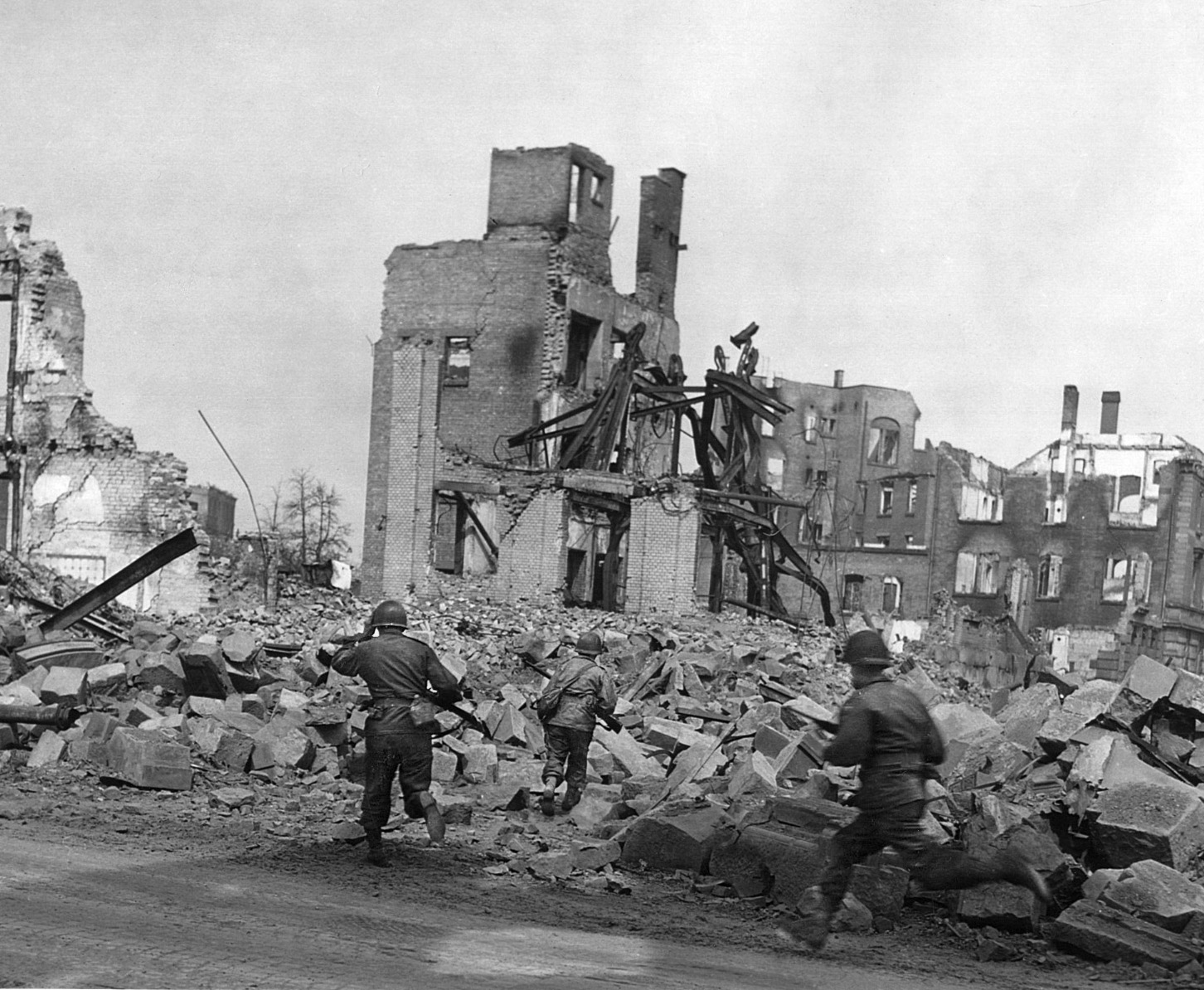
Rincker dashed for a large, red brick building that was a sugar warehouse, leaping over the body of a dead GI in the doorway, and followed by Petracco. Once inside, the two men could hear a German machine gun firing from outside the other end of the cavernous building. Taking Rincker and another soldier with a bazooka with him, Lieutenant Petracco climbed a ladder to a metal catwalk that ringed the interior.
Reaching the other end, the men looked out the window. “From this window,” Rincker said, “we could look down and see a small, one-story building about 50 feet from the end of the warehouse. Periodically a machine gun fired from this building toward our men who were trying to advance down the street.”
Petracco directed the bazooka man to fire at the building; he did, but it failed to put the machine gunner out of action. Instead, a German ran out of that building and into the warehouse, where he sprayed the catwalk with automatic weapons fire. Luckily, no one was hit. Rincker radioed for mortar fire on the small building and, after a couple of rounds to register the weapon, nine rounds were dropped on the building, silencing the gun. Lieutenant Petracco was killed later that day.
After this action, with the day growing dark, the exhausted Rincker was resting in another building in the factory area when a tremendous firefight broke out around the building, setting it ablaze.
“In the light of the fire,” Rincker said, “I could see that there were Germans all around our building, so escape seemed impossible. I didn’t relish being burned to death, but it seemed that all the GIs around me were either dead or knocked out by the terrible concussions. At this point I decided I’d rather die in a hail of bullets than be burned up, so I made my way to a doorway.”
He ran out and dashed into another building in which there happened to be about a dozen Company E men. The Germans surrounded the building and then entered, chasing the GIs to an upper story. Rincker was unable to raise anyone on his radio, but he heard a voice calling for an artillery strike on the building he was in!
Within minutes the area erupted in huge explosions. Rincker said, “I was on the second floor in a central hallway when a brilliant flash and deafening blast took place right over my head. I was knocked down, stunned, and maybe knocked out momentarily. I remember getting up and being covered with whitish dust. My head hurt, and I felt quite dizzy. About then the artillery fire ceased, and it was rather quiet till daylight.”
That morning Rincker and the other survivors were found by their buddies and evacuated to an aid station; he was soon back with his company.
For the next two weeks, more battles were in Clarence Rincker’s future. Somehow, though, the end of the war came, and he was still alive. The 100th Division had endured 175 days of sustained combat, during which time they lost 916 men killed, 3,656 wounded, and 180 missing in action.
Rincker happily recalled, “The war in Europe was over! I had walked through the Valley of Death and had come out the other side unscathed! There was no question that the Lord had been looking after me.”
After the war, Clarence Rincker became an agronomist with the Agricultural Research Service, U.S. Department of Agriculture, in Prosser, Washington. He allowed the author to quote extensively from his memoirs.
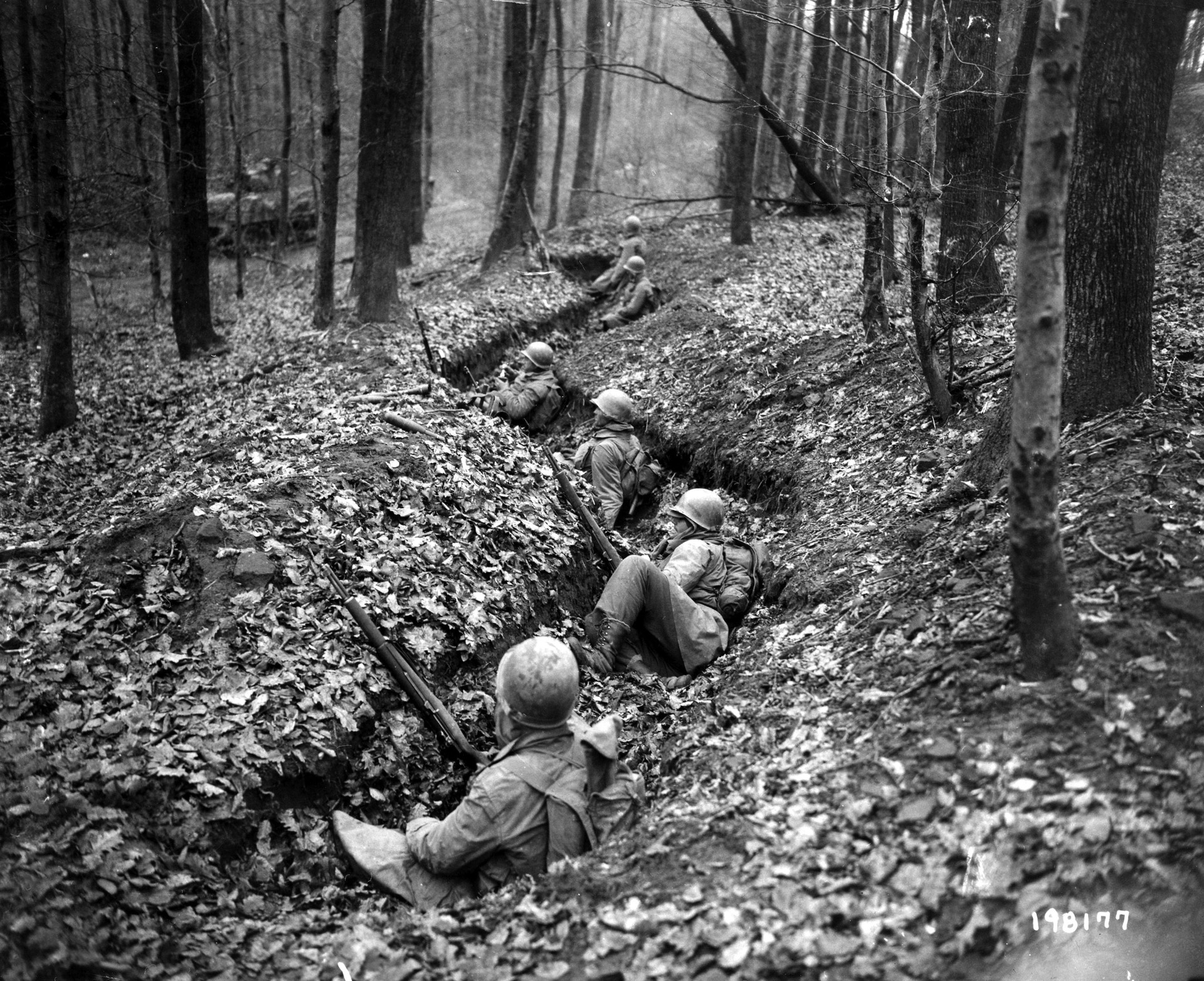

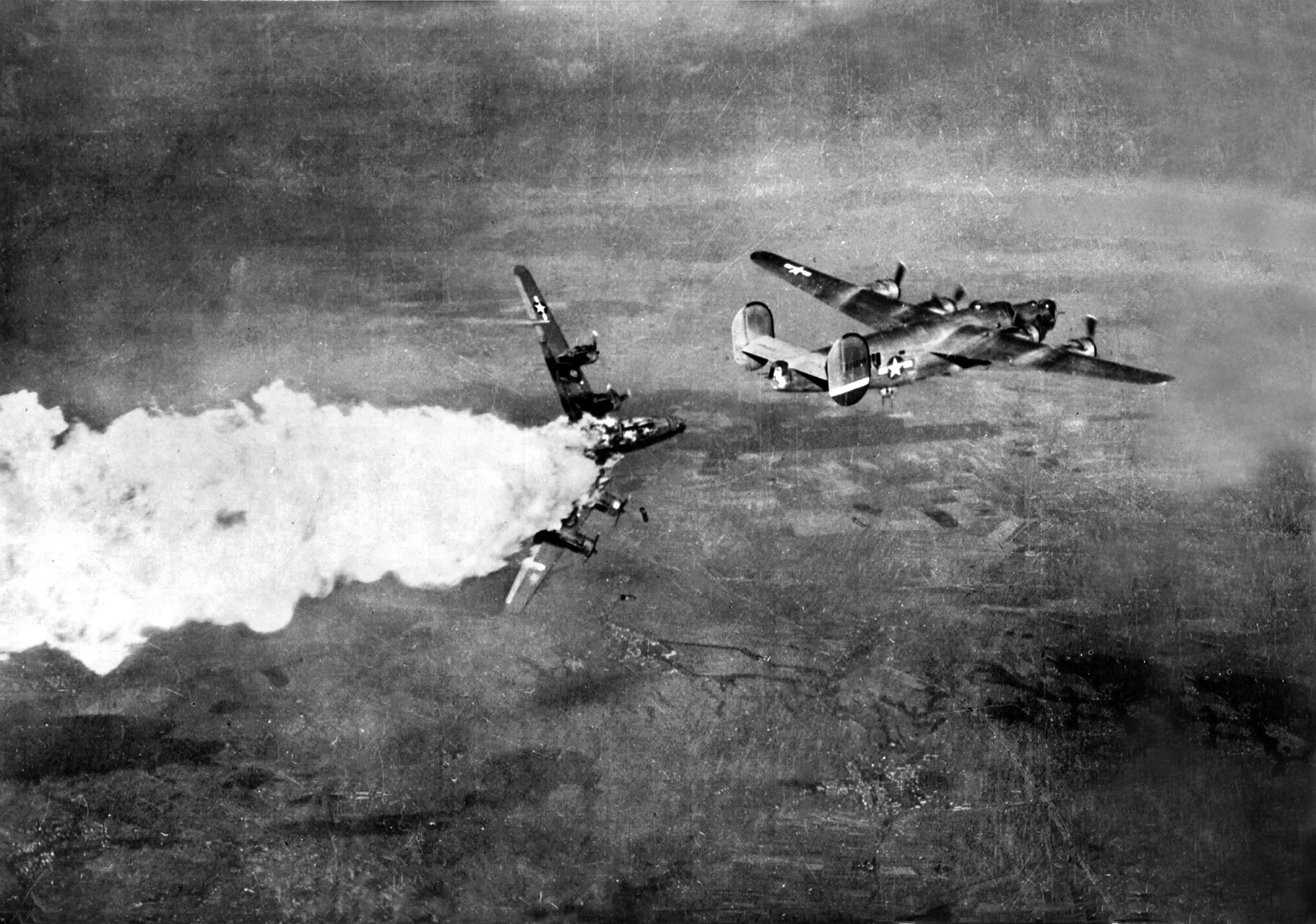
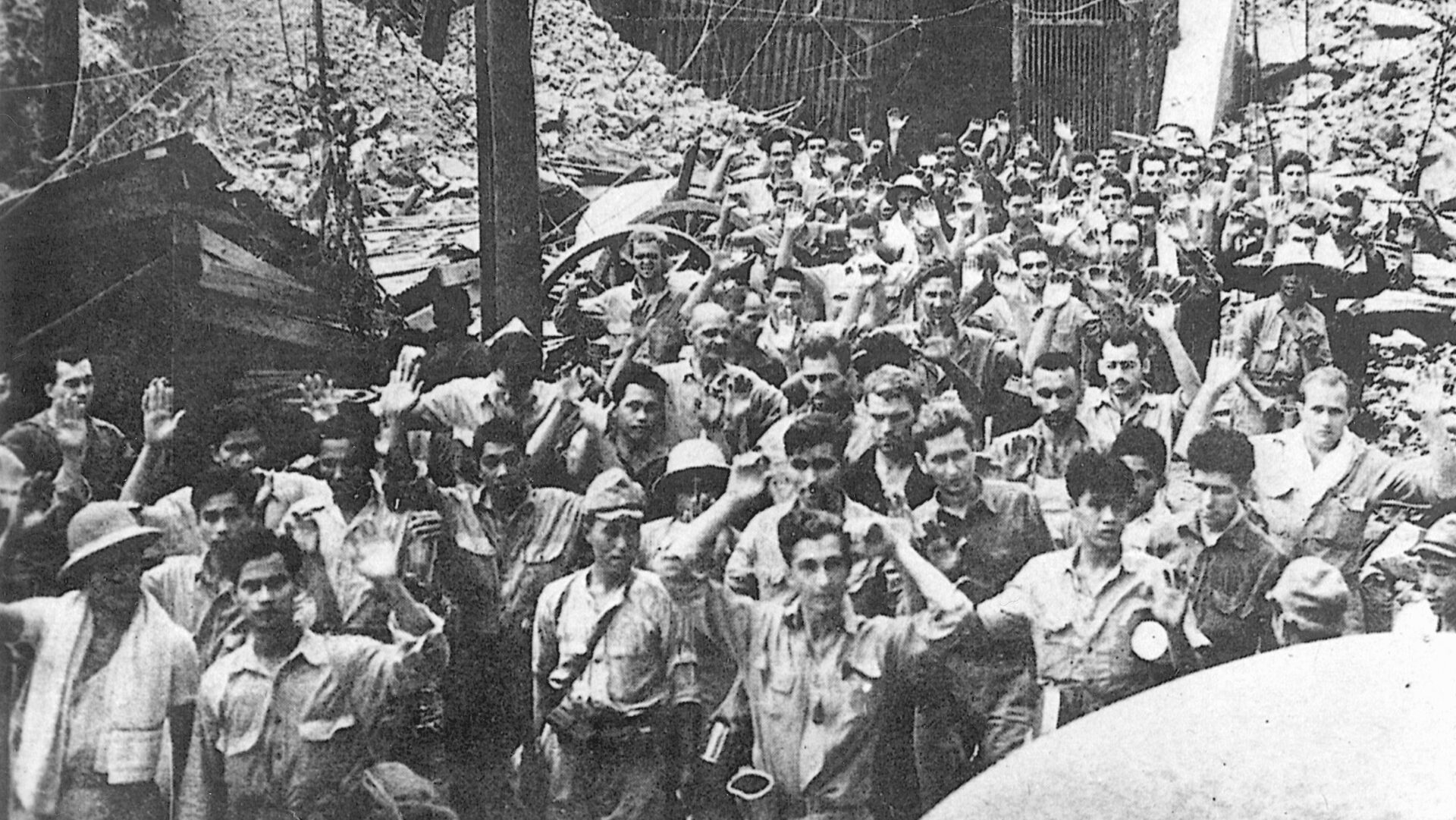
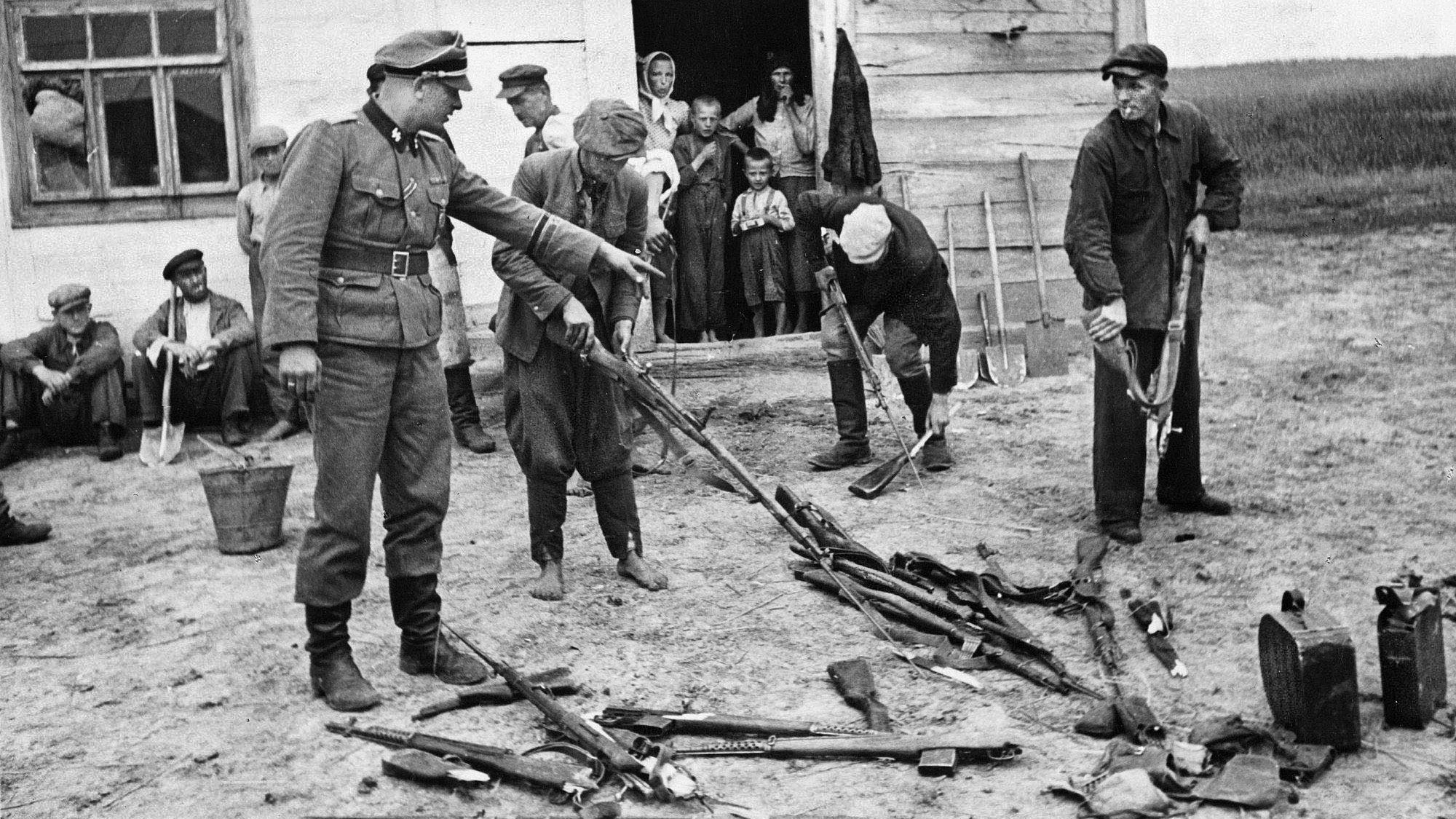
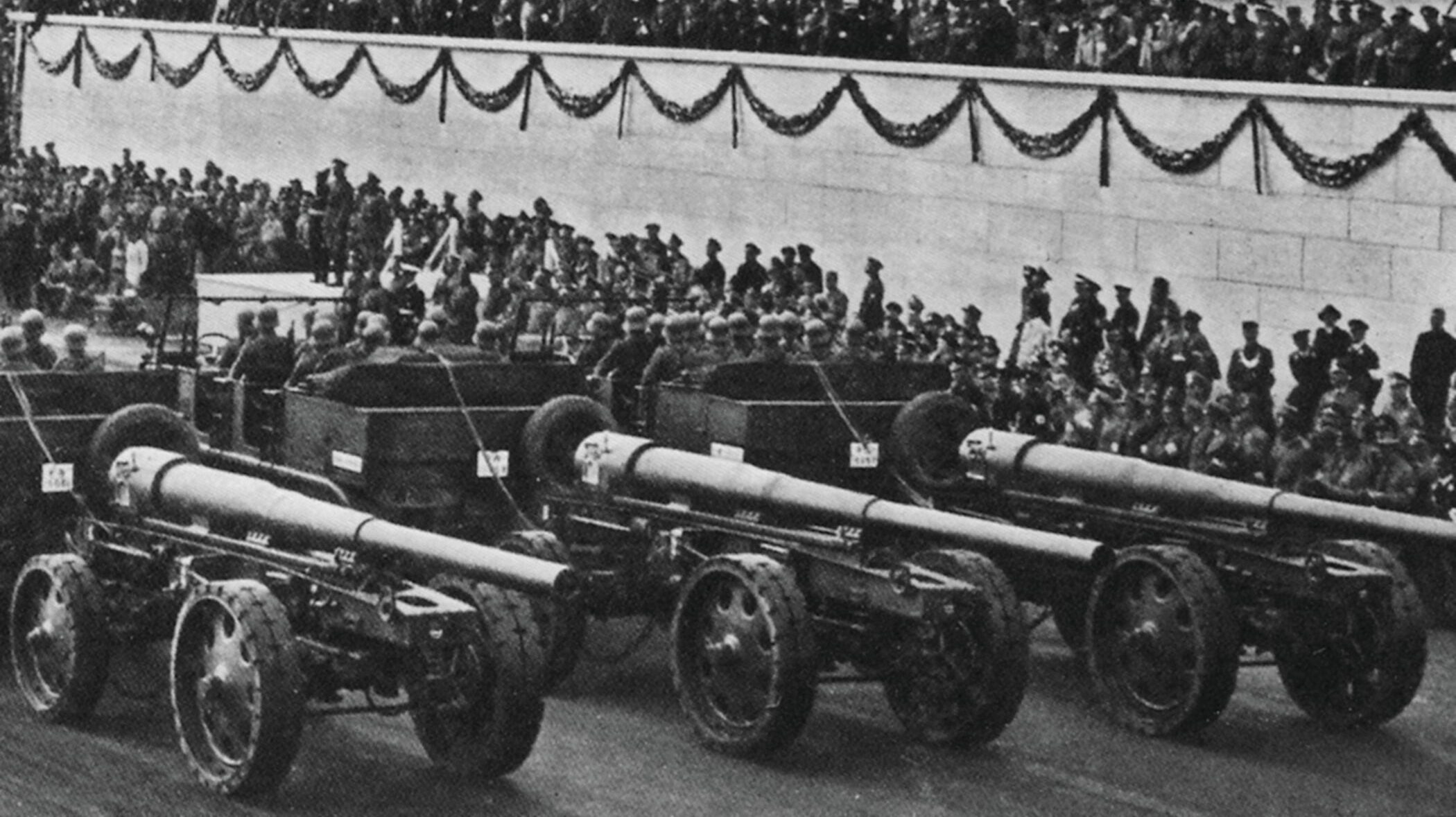
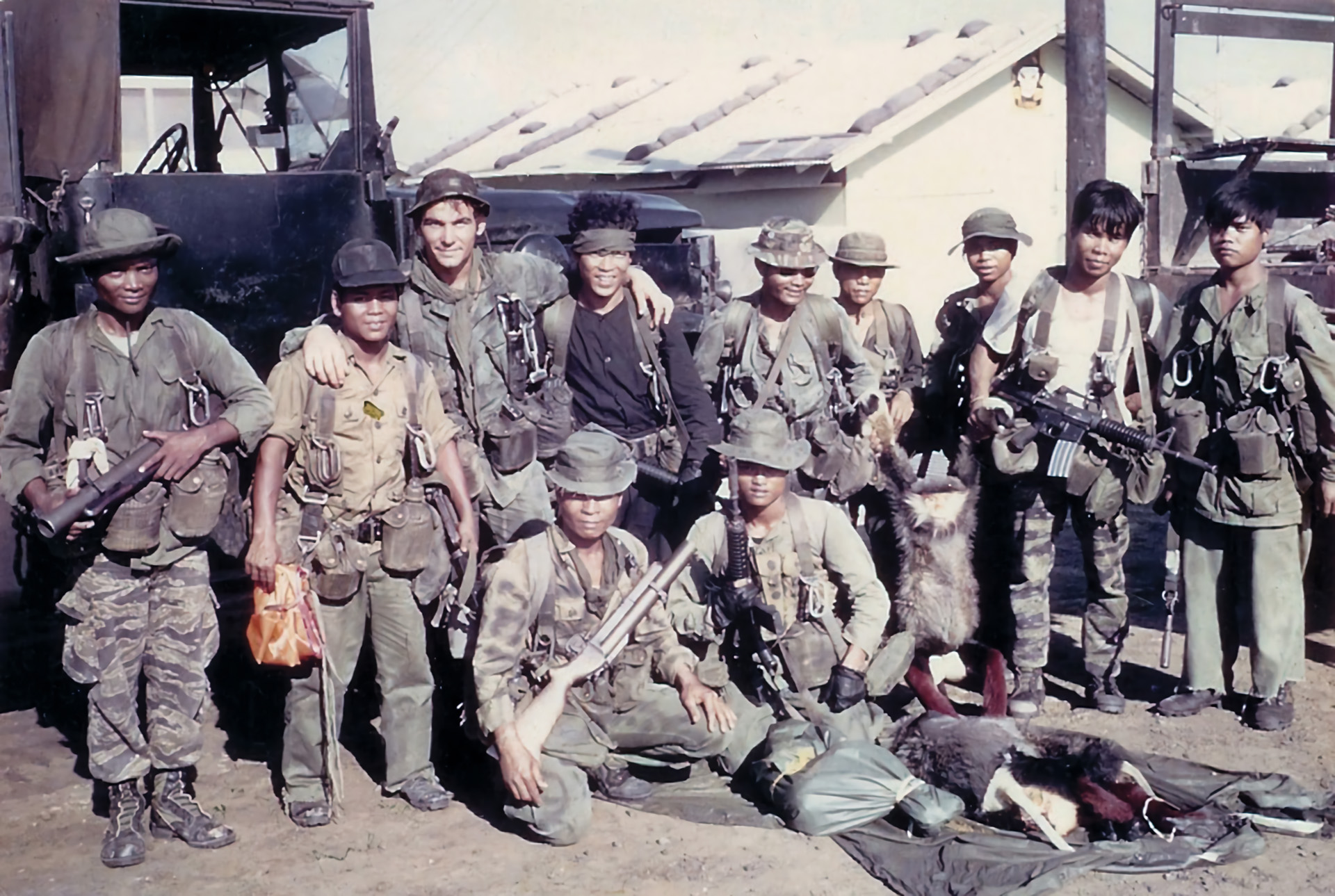
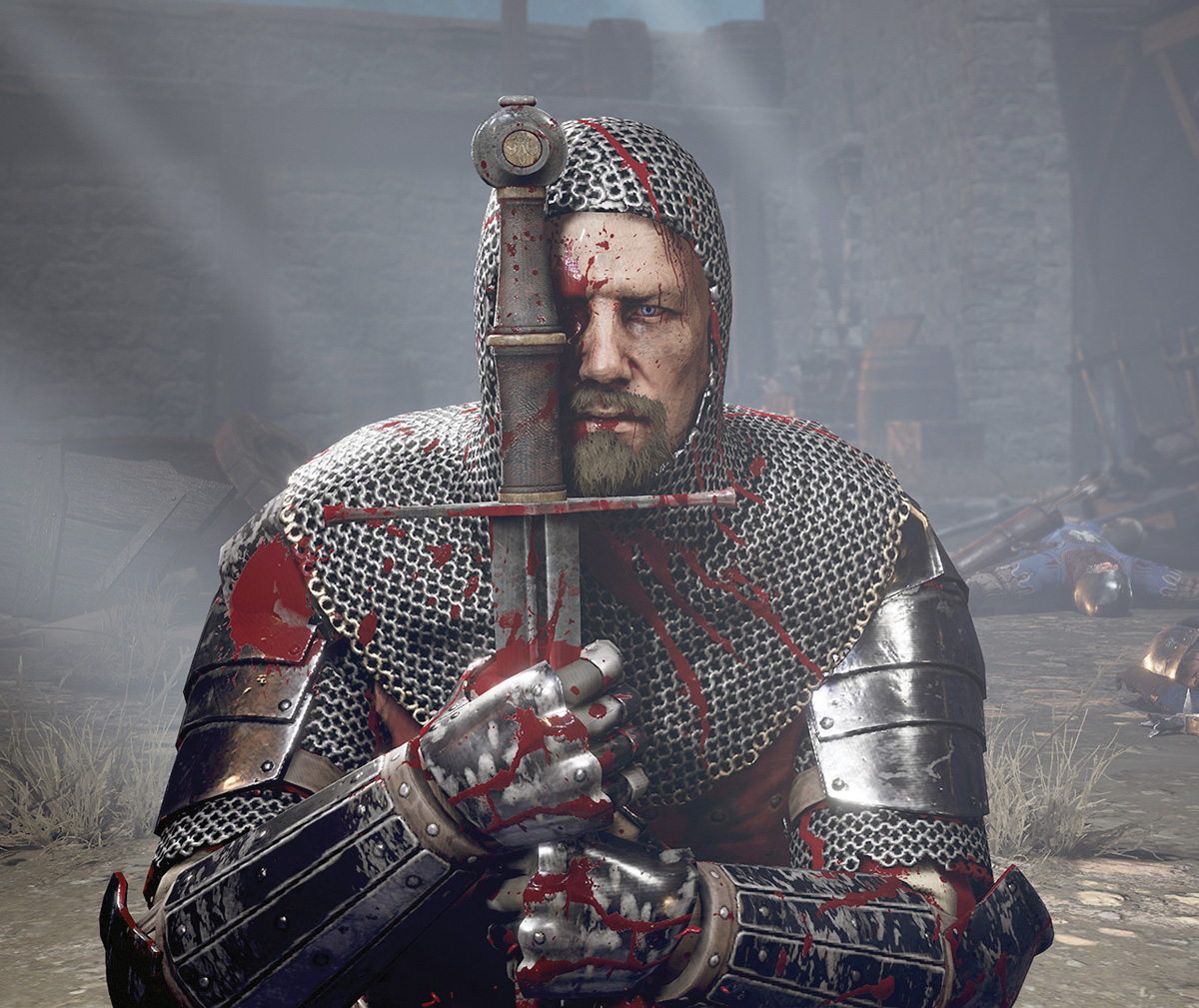
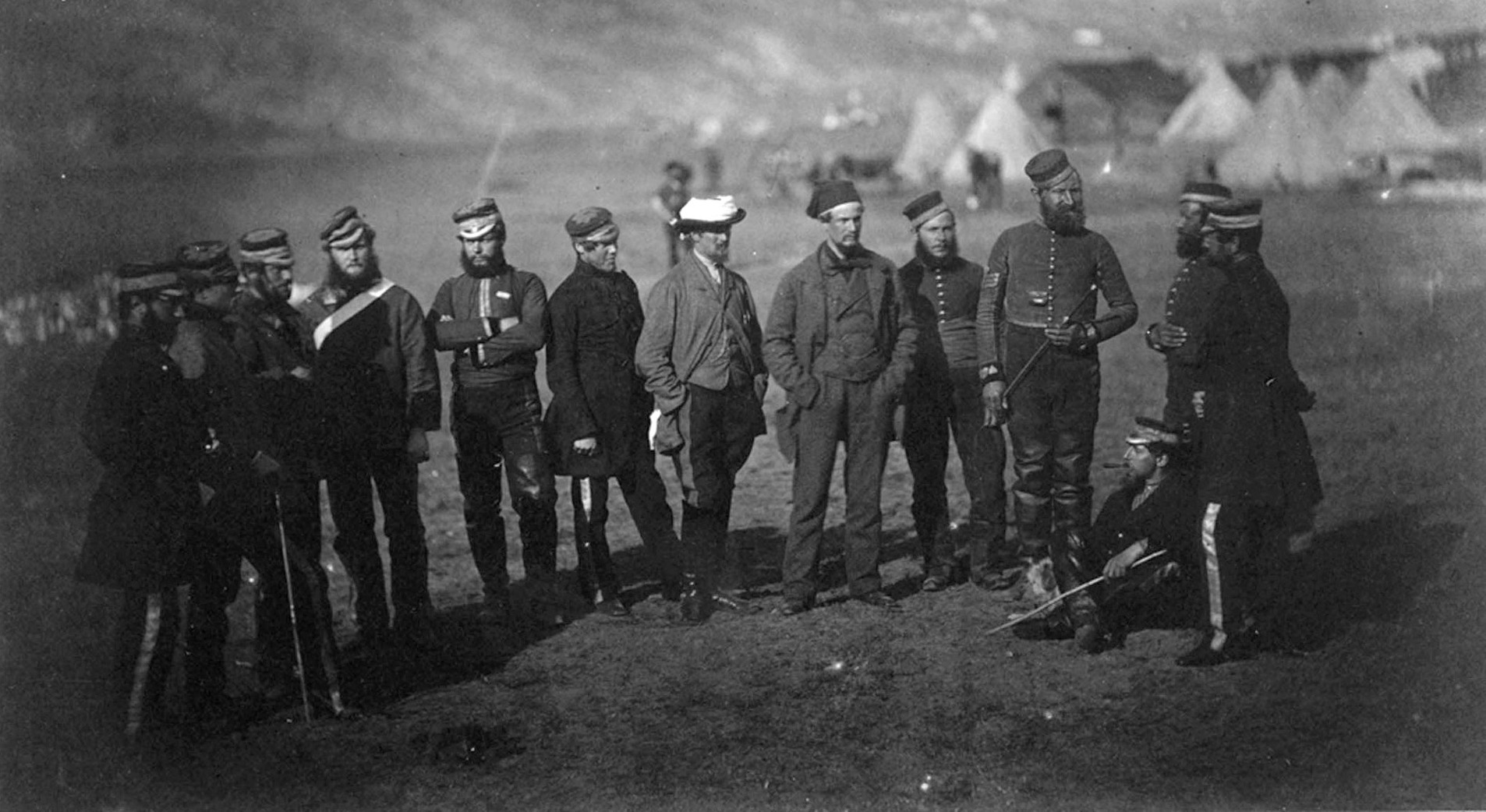
Unbelievable heroism and sacrifice